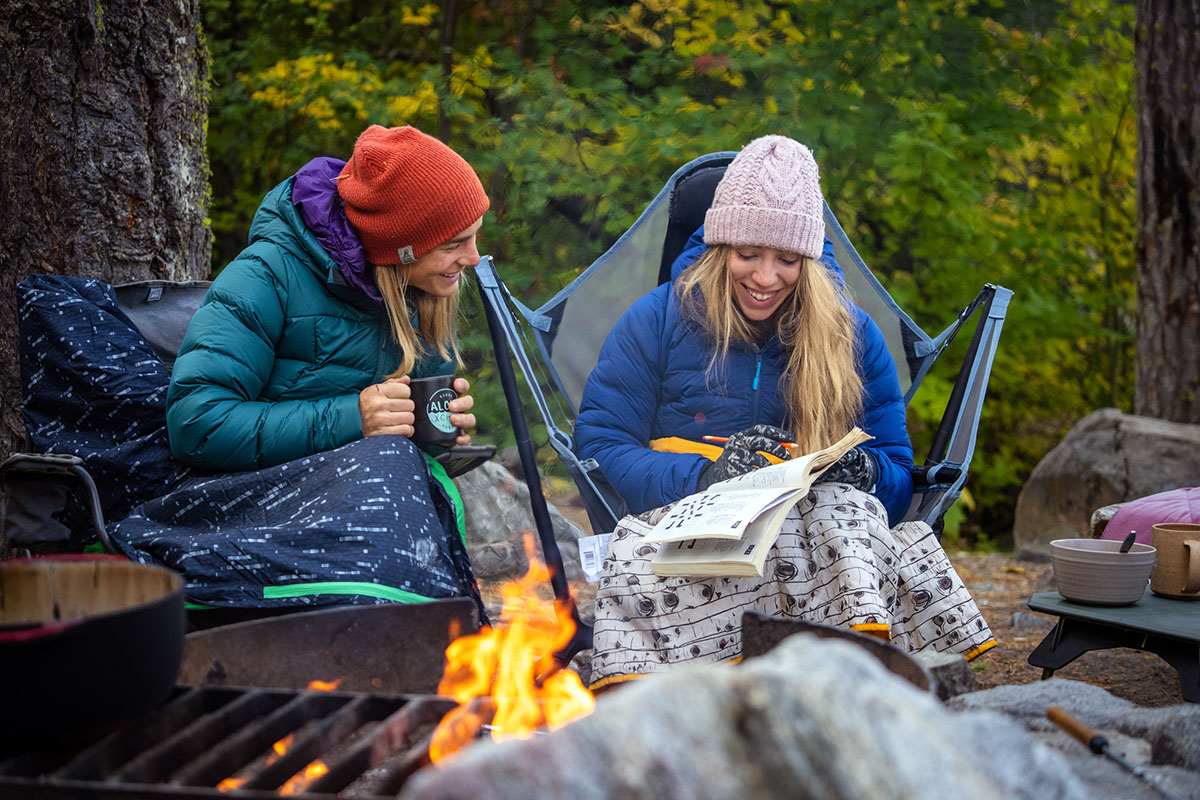
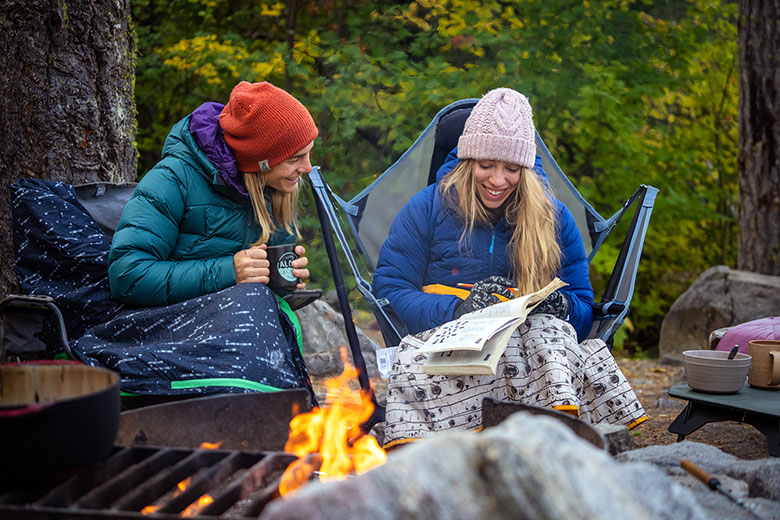
Switchback Travel (Jason Hummel)
Comfort is the number one consideration for many campers (ourselves included), and a quality camping blanket can go a long way toward keeping you warm and cozy in the wilderness. These simple yet endlessly versatile items typically feature a durable shell and synthetic insulation, although there are a number of down-filled alternatives that offer a boost in warmth and better compressibility at a lower weight. Rounding out the market are some long-lasting, classic wool and fleece options. We’ve tested dozens of camping blankets since early 2022, and below are our top 15 picks for 2024, with a detailed comparison table and buying advice below to help you choose the best blanket for your adventures.
Editor’s note: We updated this guide on June 11, 2024, to add the thin and packable Nomadix Festival Blanket and versatile Kammok Firebelly 30 to the list. We also included information about our testing practices and swept the guide to ensure all information is up-to-date at the time of publishing.
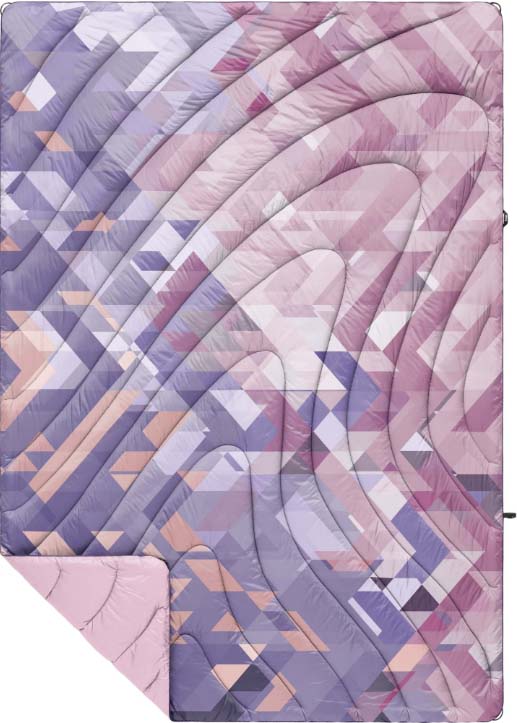 Insulation: Synthetic
Insulation: Synthetic
Weight: 2 lb. 1.6 oz.
Shell: 30D
What we like: An iconic camping blanket that's durable, cozy, and comes in a variety of fun patterns and colorways.
What we don’t: Not as warm and packable as a down design.
Founded in 2014, Rumpl is a relative newcomer to the outdoor scene, but make no mistake: This Oregon-based brand helped define the modern camping blanket as we know it. Their flagship model is the Original Puffy, which checks all the boxes we look for in a quality and versatile design. You get thick synthetic insulation that's great for three-season use, a reasonably hardwearing 30-denier shell with a durable water-repellent (DWR) coating to shed light rain and snow, and an excellent selection of vibrant patterns and colorways (including fun “Artist Division” and National Park collections). The features are nicely sorted, too, including a “Cape Clip” that allows you to secure the blanket around your shoulders to go hands-free, and corner loops to anchor it down in wind. All told, it’s a thoughtfully built and highly functional design that will keep you cozy on chilly evenings outside.
The Rumpl Original Puffy Blanket is decently roomy at 75 inches long by 52 inches wide, but taller campers or those with larger builds might want to step up to a bigger option like Kammok’s Firebelly 30 below (88 x 55 in.) to maximize coverage—or consider a two-person design like Therm-a-Rest's Argo below. On the other hand, you can get more warmth for the weight with a down-insulated alternative like Rumpl’s own Featherlite Down (not included here) or Down Puffy Blanket below, but we like the wet-weather assurance of synthetic fill—not to mention the cheaper price point (the down models cost significantly more at $400 and $250 respectively). In the end, the Original Puffy here has the widest appeal—it fits the part whether you're tailgating, camping, or just curling up with a book—earning it our top spot for 2024.
See the Rumpl Original Puffy Blanket
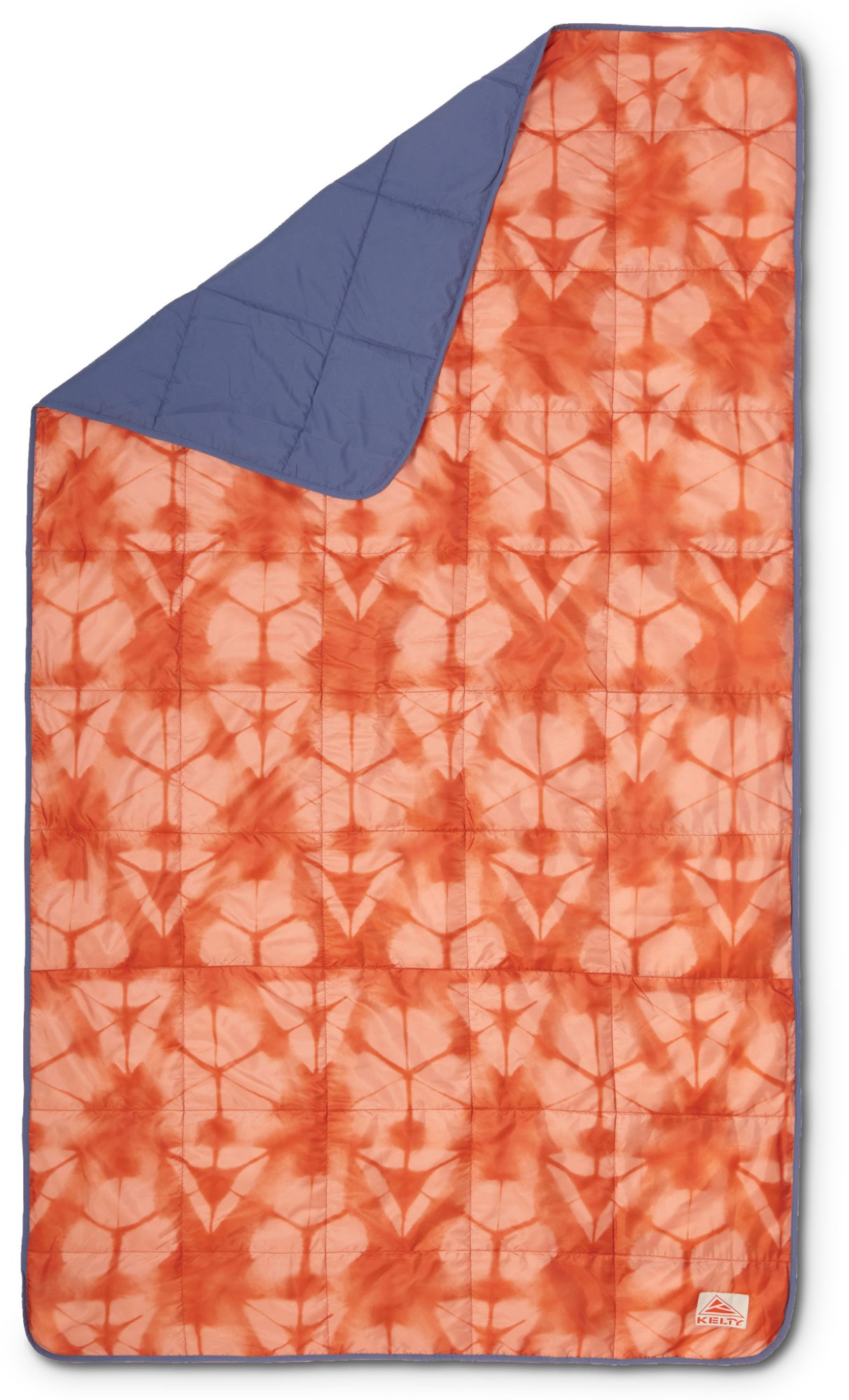 Insulation: Synthetic
Insulation: Synthetic
Weight: 1 lb. 8.6 oz.
Shell: 75D
What we like: Great durability and fun prints at a very low price point.
What we don’t: A step down in warmth, size, and overall quality from many designs here.
Premium camping blankets typically cost upwards of $100 or more, but Kelty’s Bestie Blanket stands out as a well-rounded option at an impressively low price point. For just $25 (a whopping $100 less than our top-ranked Rumpl), the Kelty boasts a cozy synthetic build with soft-brushed fabrics on both sides that surprised us with great next-to-skin comfort. The 75-denier shell is also noticeably thick and confidence-inspiring for use around dogs (we've thoroughly tested this), sharp gear, and rocks, and the colorway selection—while not up to Rumpl’s standards—comprises a few fun designs and patterns. Added up, the Bestie is a comfortable and hardwearing blanket that easily outperforms its price tag.
What do you sacrifice with the budget Kelty Bestie Blanket? In addition to being thinner and less warm than lofty designs like the Rumpl Original above, the Kelty is on the narrower end at just 42 inches wide (compared to 52 in. for the Rumpl). In practice, we found it roomy enough for covering most of our upper body and legs while sitting around the campfire, but for sleeping, any slight movement can result in exposed skin. In addition, you miss out on extras like a clip for securing the blanket cape-style. But you’d be hard-pressed to find better performance for less, making the Kelty an easy choice for budget-conscious shoppers looking for a versatile outdoor blanket.
See the Kelty Bestie Blanket
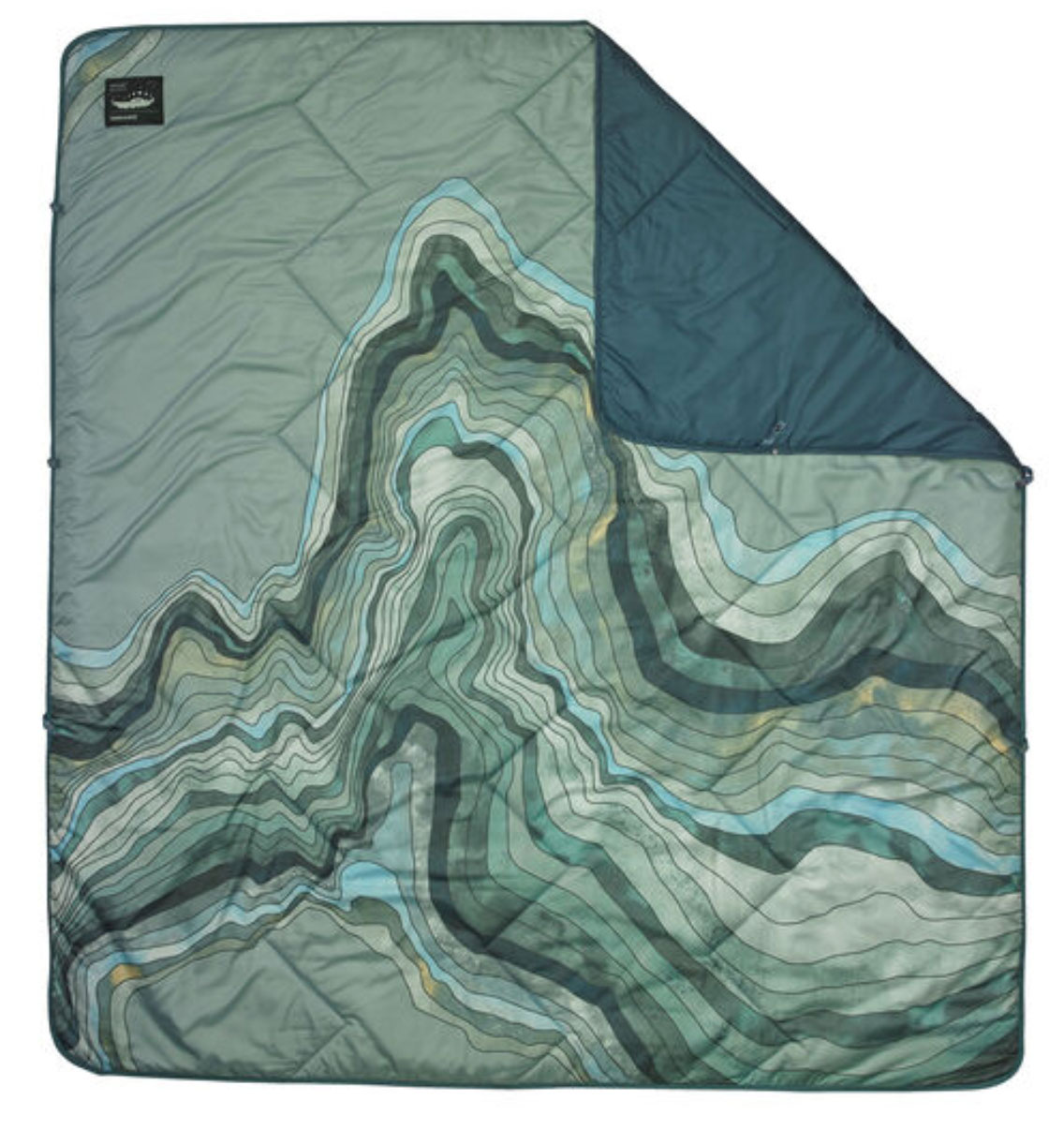 Insulation: Synthetic
Insulation: Synthetic
Weight: 1 lb. 10.0 oz.
Shell: 30D
What we like: Generous dimensions for two and functional warmth-trapping features for a reasonable price.
What we don’t: Noticeably thinner and less insulated than most of the competition.
For those who regularly camp as a pair, a double blanket can be a fun and practical alternative. Therm-a-Rest’s Argo is our favorite option in this category, combining a low price with generous dimensions for two (its 78 x 72 in. build is nearly the size of a king bed) and functional warmth-trapping features. Specifically, the drawcord at the bottom is great for keeping the blanket in place and minimizing drafts at your feet, and snap loops at the sides allow it to pair with another Therm-a-Rest blanket or quilt. We also appreciate the built-in stuff pocket, which can double as a pillow and reduces the risk of losing a separate sack. And despite the roomier build and fairly large 14 x 17-inch packed size, Therm-a-Rest managed to keep weight impressively low at just 1 pound 10 ounces, which undercuts many of the single-person blankets on our list.
In keeping weight to a minimum, however, Therm-a-Rest did have to sacrifice some warmth. To be clear, the Argo is a viable option for summer evenings, those who run warm, or as a supplement to a quality sleeping bag in the shoulder seasons, but it’s noticeably thinner and less insulated than loftier designs like the Rumpl Original Puffy above. On the flip side, the single-person Rumpl may be too small for some, and stepping up to the two-person version will cost you a steep $220. In other words, the Argo is far and away the better value, and a two-person quilt is a bit more about friendship than function to begin with (plus, sharing body heat can offer a considerable boost in warmth). For an even cheaper but less premium two-person design, check out Kelty’s $50 Biggie Blanket.
See the Therm-a-Rest Argo Blanket
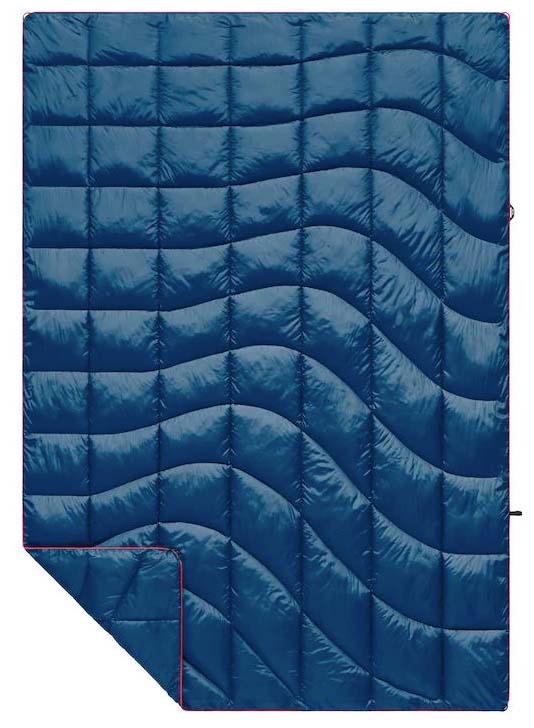 Insulation: 600-fill-power down
Insulation: 600-fill-power down
Weight: 1 lb. 3.2 oz.
Shell: 30D
What we like: Lofty down insulation is very warm and highly compressible.
What we don’t: Not the best value.
Rumpl’s Original Puffy Blanket above is impressively well-rounded and versatile (hence our ranking), but it’s not the lightest or most packable design on the market. Enter Rumpl’s Down Puffy Blanket, which swaps the standard model’s synthetic fill for loftier and more compressible 600-fill-power down. In addition to providing similar warmth for around a pound less, the Down Puffy packs down much smaller for storing in a backpack or travel bag (we found it’s about 1/3 the size of the Original Puffy in its stuff sack) while offering a modest boost in coziness. Rumpl also addressed two of the biggest pitfalls of down—lack of wet-weather protection and propensity to leak feathers—by equipping the Down Puffy with hydrophobic down, a quality DWR coating, and a decently tough 30-denier shell. A final highlight is the focus on sustainability, including a 100% recycled shell and traceable down insulation that’s a byproduct of the food industry (i.e., no live plucking).
All in all, the Rumpl Down Puffy Blanket is pretty well balanced for its light and premium build, but it’s still a steep investment at $250. For half the price, the Kelty Galactic Down below uses only slightly lower-quality 550-fill down (although it’s not hydrophobic) and has a significantly thicker 50-denier shell that will stand up better to long-term outdoor use. You do make noticeable compromises in weight (the Kelty comes in 9.4 oz. more) and packed size, and the Galactic Down's lining and shell fabric feel decidedly less premium. Those trade-offs may be worth it for budget-focused campers looking to save, but if you can bite the bullet, the Rumpl's high-end finishes and impressive warmth-to-weight ratio are undeniably enticing. For an even lighter and more compressible option from Rumpl, their top-end Featherlite checks in at a scant 1 pound and packs down to just 5 x 8 inches but has a concerningly thin 10-denier shell and is eye-wateringly expensive at $400.
See the Rumpl Down Puffy Blanket
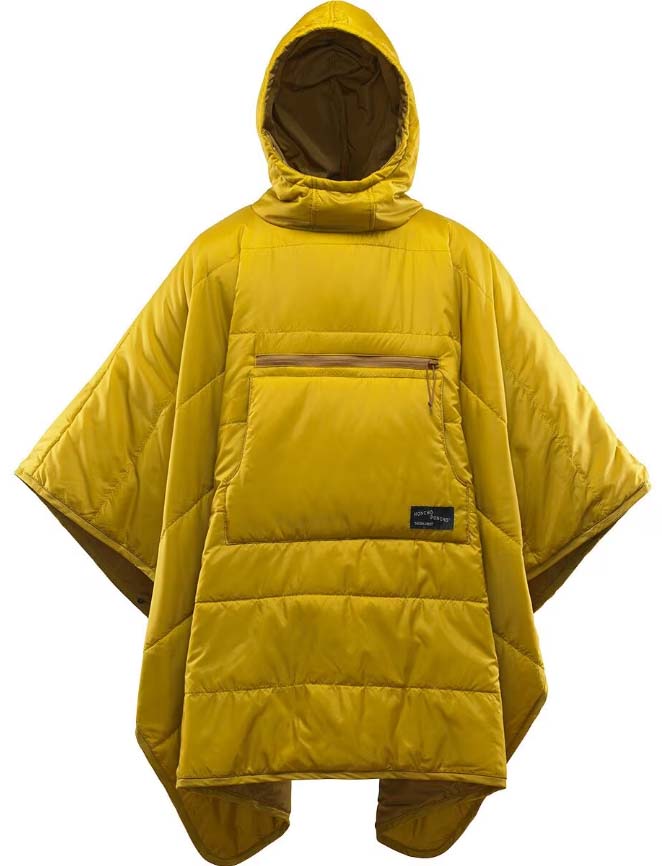 Insulation: Synthetic
Insulation: Synthetic
Weight: 1 lb. 8.0 oz.
Shell: 20D
What we like: A wearable blanket—complete with a hood—for maximizing warmth and coverage.
What we don’t: Small neck opening, no hood drawcord, and not everyone will love the look.
Poncho-style blankets are a popular and growing trend, with Therm-a-Rest’s Honcho Poncho leading the charge. Laid flat, the Honcho Poncho looks a lot like a standard camping blanket, including quality synthetic insulation stuffed inside a water-resistant polyester shell. However, with the addition of a hood and two pockets at the front—one zippered pocket and one open kangaroo-style pouch—the Honcho Poncho is significantly more appealing as a wearable piece. Simply throw it on when the mercury drops, connect the snaps at either side, and move around as you normally would. All in all, it’s a functional two-in-one design that makes it easy to stay warm while performing camp chores or stepping out for a bathroom break in the middle of the night.
As we alluded to, Therm-a-Rest isn’t the only brand to offer a poncho-style blanket. For example, Rumpl sells their Original Puffy in a poncho version, which tacks on practical features like drawcords to adjust the hood and a beverage holder inside the kangaroo pouch. However, the Rumpl is pricier at $175 and can't be fully unfolded like the Honcho Poncho. For a cheaper alternative, REI’s Campwell Camp Wrap will save you $35 compared to the Therm-a-Rest but secures around the front (rather than at the sides), which results in less coverage. To be sure, the Honcho Poncho isn’t perfect—the neck opening is on the smaller end, there’s no drawcord for cinching the hood, and we wish there were a couple more snaps for securing the sides. But overall, it’s a very well-executed and fun setup for campers looking to maximize coverage. For the ultimate in warmth, Therm-a-Rest also offers a down-insulated variation for $260, although it can’t be used as a standard blanket due to the sleeves.
See the Therm-a-Rest Honcho Poncho
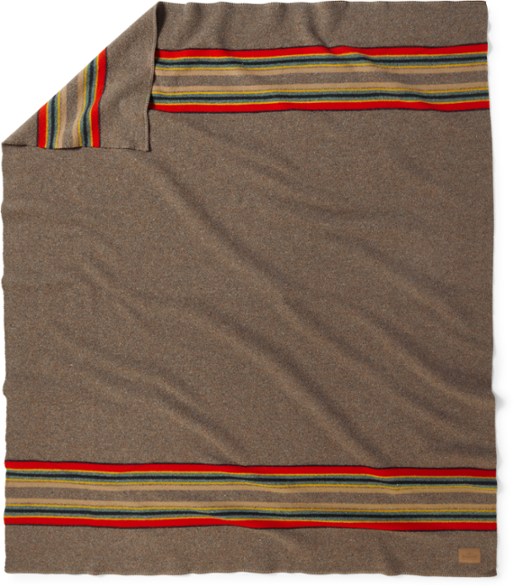 Insulation: Wool (86% wool, 14% cotton)
Insulation: Wool (86% wool, 14% cotton)
Weight: 5 lb. 4.3 oz.
What we like: A beautiful wool blanket with Pendleton’s exceptional craftsmanship.
What we don’t: Heavy, expensive, and less versatile than many designs here.
Pendleton has been weaving quality wool blankets since the early 1900s, and their classic designs and excellent craftsmanship are hard to beat. We’ve been long-time owners of their Yakima Camp Blanket, which is a proven option for everything from backyard gatherings to vanlife and weekends at the cabin. Rather than synthetic or down, the Pendleton utilizes the company’s hallmark wool construction, which adds a little cotton for a soft next-to-skin feel. The wool is durable, naturally odor-resistant, and warm, and the blanket has a high-end look and feel with a classy striped design and nature-inspired colorways.
However, despite wool’s softness and warmth, it’s not our favorite insulator for camping blankets. The biggest drawback is weight: At 5 pounds 4 ounces, the Yakima Camp blanket is the second-heaviest option on our list (right behind the waterproof Yeti Lowlands below) and doesn’t pack down well for stuffing in a duffel or full trunk. It's also dry clean-only, so we recommend leaving it inside the tent on camping trips to avoid collecting dirt and grime. All in all, the Yakima isn’t the most versatile option here, but it’s a warm, comfortable, and exceptionally well-built alternative to down and synthetic blankets. And if it isn't already obvious, a final bonus is that the Pendleton looks great around the house, too.
See the Pendleton Yakima Camp Blanket
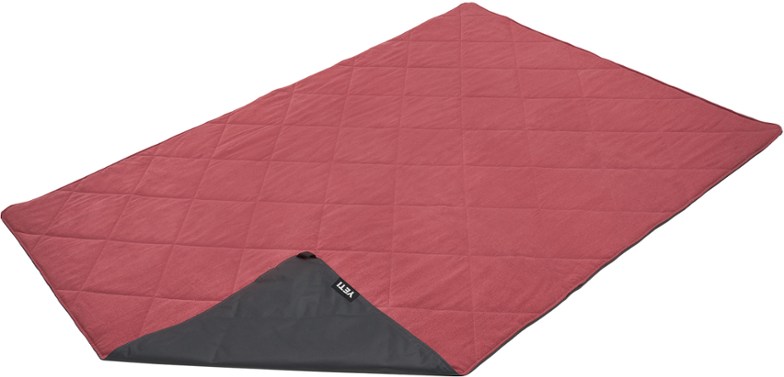 Insulation: Synthetic
Insulation: Synthetic
Weight: 5 lb. 12.8 oz.
What we like: A waterproof and highly durable option that can be used as both a blanket and ground tarp.
What we don’t: Noticeably hefty and lacks the all-out comfort of standard camping blankets.
Cooler giant Yeti is well known for their premium take on camping gear, and the Lowlands Blanket carries the torch. In a departure from the more traditional designs here, the Lowlands is essentially two blankets in one: The interior is nicely padded with synthetic insulation, while the exterior boasts a durable and waterproof layer that effectively sheds moisture, pet hair, and other debris. For reference, we spilled a full water bottle on the blanket during testing, and the droplets quickly beaded up and rolled off the top without soaking into the fabric. Dirt buildup is a similar story: Even with a wet dog lying on top for hours, the Lowlands looked surprisingly fresh at the end of the day. To be clear, this blanket is too stiff and large to cozy up with around the fire—it’s best used as a premium ground cloth—but the soft and insulated top layer adds some versatility if you want to roll up the sides around your legs for warmth.
Yeti isn’t the only brand to offer a design like this, and the Lowlands certainly isn't the cheapest. For a considerable $50 less (for the XL size), Nemo's popular Victory Picnic Blanket also sports a waterproof bottom and adds functional extras like a stash pocket and integrated straps that keep it neatly wrapped up when packed down. It’s also considerably lighter, although it’s uninsulated and doesn’t offer the same two-in-one versatility as the Lowlands. We also like Rumpl’s Everywhere Mat, which boasts a soft microsuede top and waterproof base for a significant $120 less than the Lowlands. But again, the Yeti stands out for its functional multi-purpose build, which is excellent for camping, concerts, tailgates, and other activities when you want both ground protection and insulation. If you can justify the cost, it’s an exceptionally made and functional all-around design.
See the Yeti Lowlands Blanket
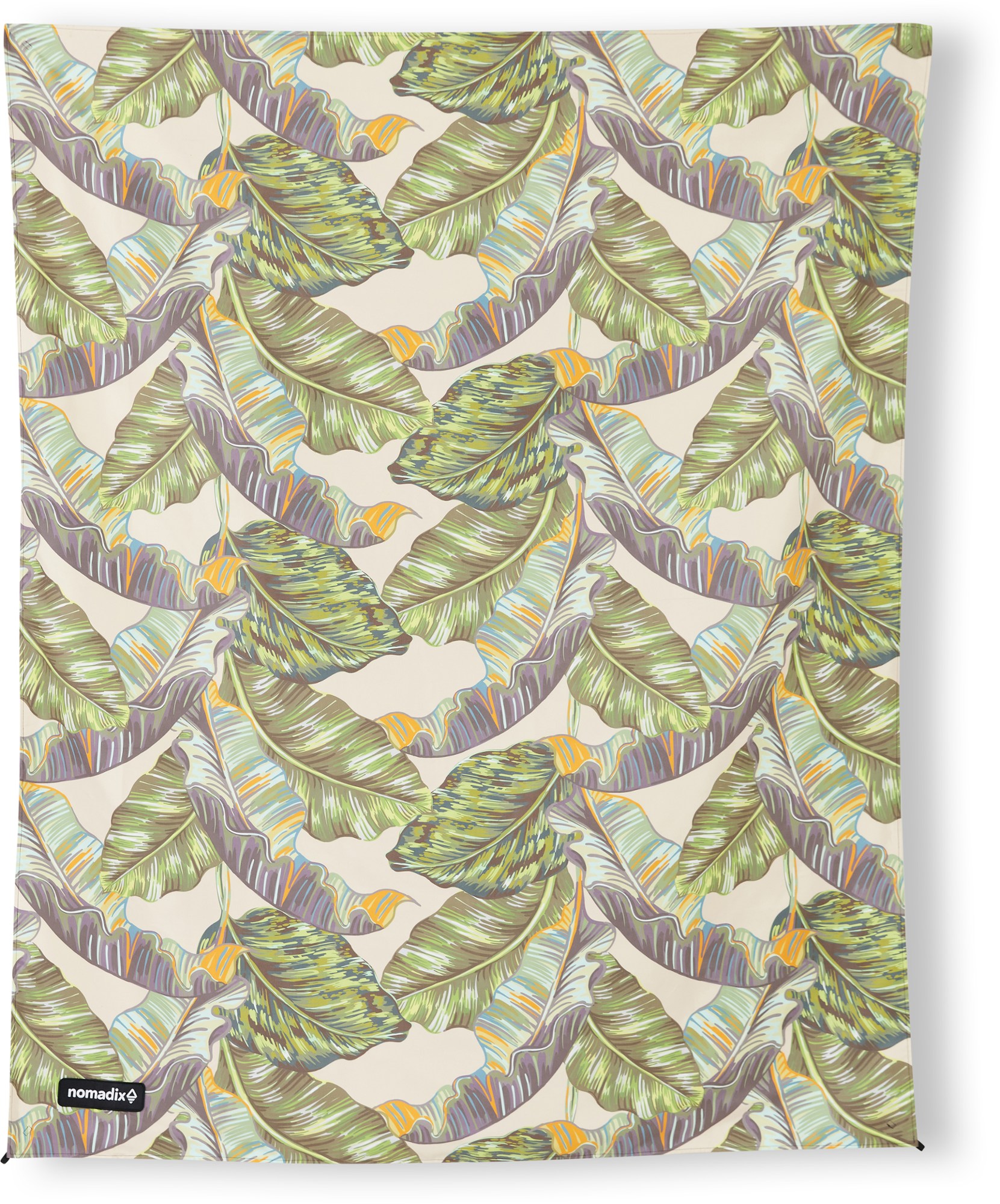 Insulation: None
Insulation: None
Weight: 2 lb. 0 oz.
What we like: Fun patterns and packs down small—great for picnics, festivals, and travel.
What we don’t: Uninsulated design offers minimal warmth.
The vast majority of camping blankets on our list are insulated, but there’s a time and a place for a simple, uninsulated design like the Nomadix Festival Blanket. One benefit to the basic build is that it packs down extremely small, making it easy to throw in a backpack or tote for days at the beach, picnics at a local park, or even while traveling. All of the materials have a very soft and supple feel, do a great job at repelling moisture (we have no concerns about setting it down on dewy grass or damp sand), and are great at sloughing off debris like grass and pet hair. Finally, we can’t help but love the healthy selection of eye-catching designs and strong sustainability slant (each blanket is made from 58 recycled plastic bottles).
While fairly obvious, the biggest trade-off to the Nomadix Festival Blanket’s uninsulated build is that it offers minimal warmth. Instead, we’ve found it best suited for use as a ground cloth—similar to the more premium but synthetic-insulated Yeti Lowlands above. In other words, the Nomadix is a nice supplemental option but can’t replace a standard camping blanket when it comes to keeping you warm, whether you’re telling stories around the campfire, enjoying some evening tunes in the park, or watching the sunset after a day on the water. If you like the look and styling of the Festival Blanket but want something insulated, check out the Nomadix Puffer, which bears a strong resemblance to our top-rated Rumpl Original Puffy for $25 less.
See the Nomadix Festival Blanket
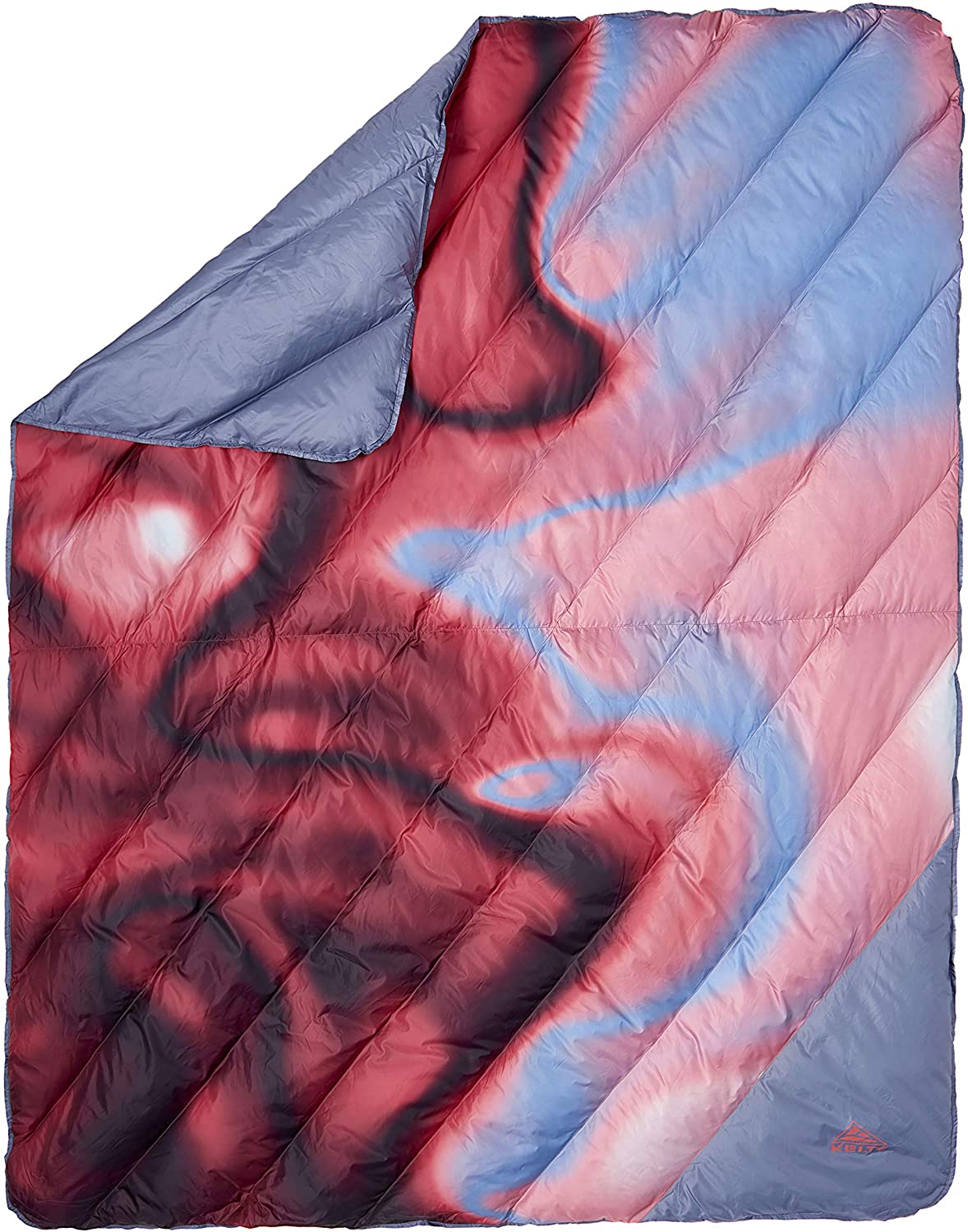 Insulation: 550-fill-power down
Insulation: 550-fill-power down
Weight: 1 lb. 12.6 oz.
Shell: 50D
What we like: Excellent price for a durable, down-insulated camping blanket.
What we don’t: Fairly heavy due to the lower-quality insulation.
Down camping blankets are an expensive bunch—as evidenced by the $250 Rumpl Down Puffy above—but budget leader Kelty offers a nice value alternative in their Galactic Down Blanket. To keep costs low, Kelty utilizes average-quality 550-fill-power down, which is much less compressible than the Rumpl’s 600-fill variety and weighs considerably more to achieve similar levels of warmth. For reference, the Galactic clocks in at a fairly hefty 1 pound 12.6 ounces, which is heavier than many synthetic alternatives on our list. But it packs down reasonably small and is noticeably robust with a thick 50-denier shell (compared to 30D for the Down Puffy) that will stand up much better over the long haul. For $125 full MSRP and often available for less on Amazon, that’s a whole lot of bang for your buck.
If you’re on a budget and prefer lofty down over synthetic, the Kelty Galactic has a lot of appeal. That said, for the same price, we prefer the top-ranked Rumpl Original Puffy, which weighs a few ounces more but adds a nice dose of wet-weather assurance—during some mid-October testing in the Pacific Northwest, the Kelty’s down fill clumped up from exposure to dew, while the Rumpl remained lofty. The Galactic also has a cheaper feel overall and lacks the cozy softness of the Rumpl. But it packs down smaller, is more durable thanks to its slightly thicker shell fabric, and is also 3 inches wider (length is around the same). Whether or not these advantages are worth the trade-offs in comfort and wet-weather assurance is up to you, but the Kelty nevertheless is a decently warm and lofty down blanket at an excellent value.
See the Kelty Galactic Down Blanket
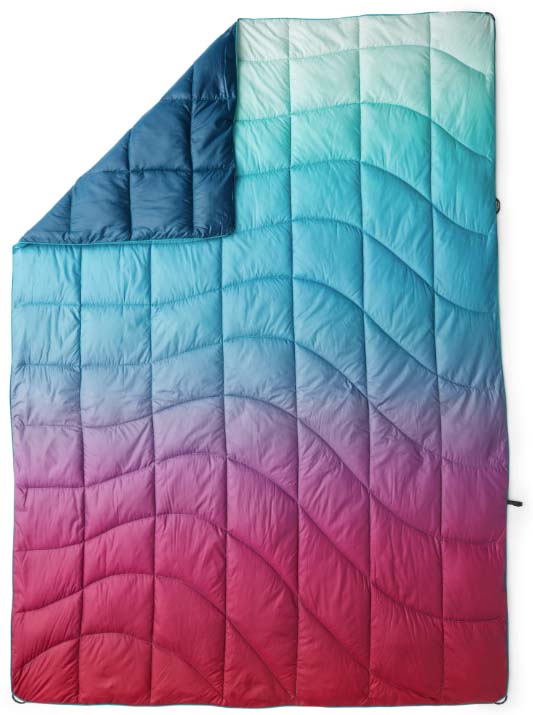 Insulation: Synthetic
Insulation: Synthetic
Weight: 1 lb. 12.8 oz.
Shell: 30D
What we like: NanoLoft insulation does a nice impression of down’s warmth and compressibility.
What we don’t: Hard to justify the price jump over Rumpl’s Original Puffy above.
Synthetic insulation can’t match the warmth-to-weight ratio or impressive packability of down, but some varieties come pretty darn close. NanoLoft is one standout, and Rumpl utilizes a healthy dose of it in their namesake NanoLoft Puffy Blanket. Stacked up against the lower-quality synthetic used in their Original Puffy above, the more premium NanoLoft variation is noticeably thicker and loftier, which results in similar warmth at a lower weight (by around 4 oz.) and significantly reduced packed size (6 x 14 in. vs. 7 x 16 for the Original Puffy). For weight- and space-conscious campers who don’t want to spend an arm and a leg on a premium down model, the Rumpl NanoLoft is a practical alternative that also gets the clear edge in weather resistance.
However, the NanoLoft’s slight advantages in weight and packability are inconsequential for most campers. For $40-$55 less (depending on colorway), the Original Puffy above offers similar overall performance with only minor trade-offs in heft and bulk, and the NanoLoft doesn’t come with any additional features. But the NanoLoft insulation does a really good impression of down for a significant $70-$85 less than their Down Puffy above, which will be enough of a draw for some (although the Down Puffy gets the clear edge in weight at 1 lb. 3.2 oz.). Finally, it’s worth noting that the NanoLoft collection also includes a smaller and more packable Travel variation, as well as the NanoLoft Flame Blanket, which uses a proprietary fire-resistant shell for fending off holes from flying embers. However, the Flame is much smaller at 52 x 38 inches and lacks the soft and cozy feel of the standard model, which limits its overall appeal.
See the Rumpl NanoLoft Puffy Blanket
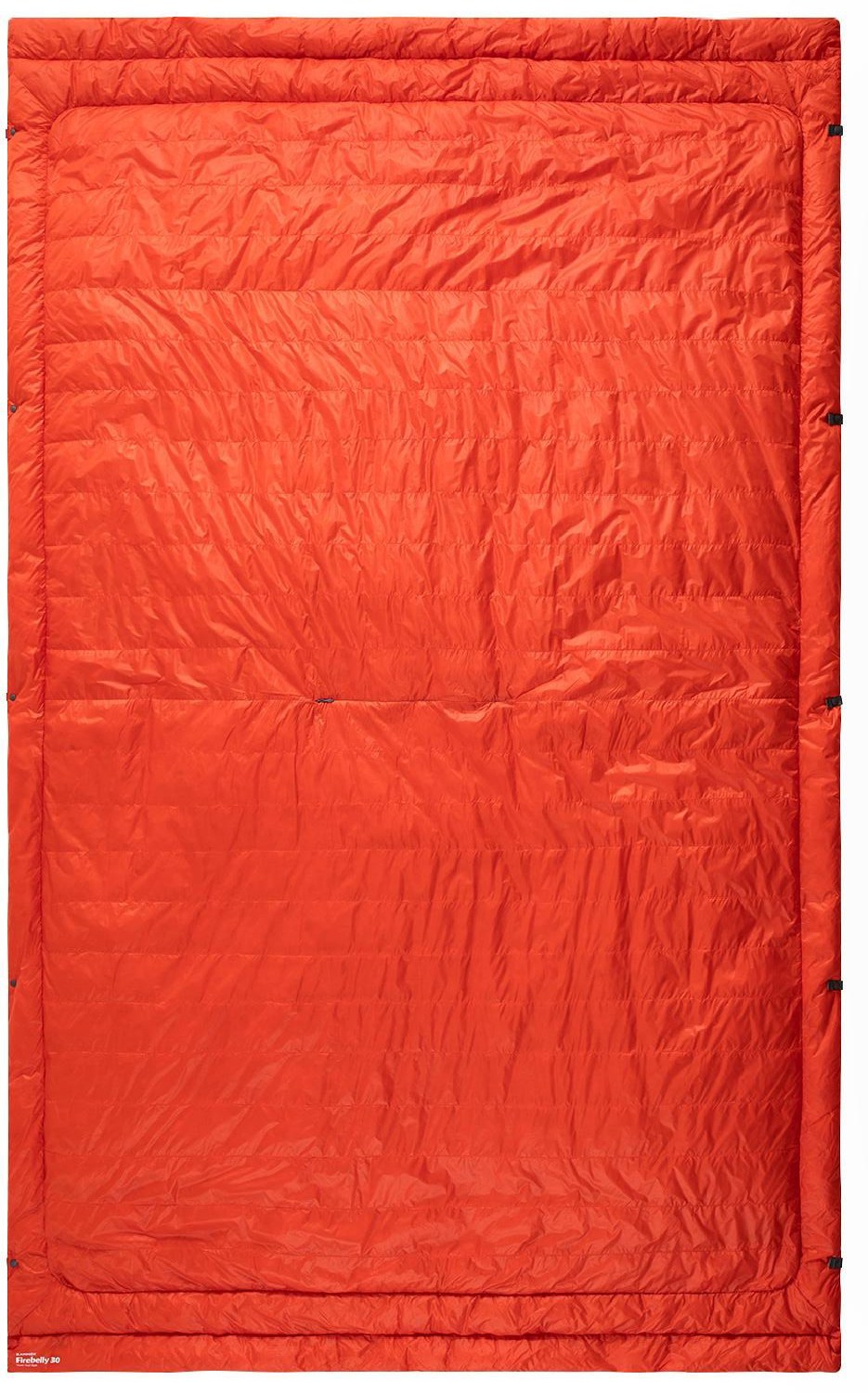 Insulation: 750-fill-power down
Insulation: 750-fill-power down
Weight: 1 lb. 12.2 oz.
Shell: 20D
What we like: A camp blanket, sleeping bag, hammock top/underquilt, and poncho all in one.
What we don’t: Expensive and not a standout in any one category.
Technically billed as a quilt, Kammok’s versatile Firebelly 30 serves a few purposes. Fully open, it’s a generously sized (88 x 55 in.) camping blanket that’s stuffed with lofty, compressible, and water-repellent 750-fill down. Snaps along the perimeter allow you to secure the sides together to transform it into a sleeping bag on warmer nights (keep in mind there’s room for air to enter between the snaps), or you can use it as a top quilt or underquilt with one of Kammok’s hammock tents or Roo hammocks. A final option is to wear the Firebelly as a poncho—complete with a cozy draft collar—by undoing the zipper to reveal the head opening. Taken together, it’s a fun spin on the traditional camp blanket and a nice do-it-all option for campers and backpackers who exclusively get out in the summer months.
However, as with many products that aim to do it all, the Kammok Firebelly doesn’t stand out in any one area. As a blanket, the Firebelly is very warm but pricey compared to many other designs here. On the other hand, it’s not insulated enough to use as your primary sleeping bag outside of the warm summer months—we don’t advise pushing it lower than around 40 degrees Fahrenheit due to the lack of EN/ISO temperature rating and draft-prone openings between the snaps. You do get drawcords at the footbox and shoulders to help seal in heat, but there’s a reason that zippered mummy bags are the standard in the backcountry. For car camping, however, we love the Firebelly’s ability to easily transform between blanket and poncho when we need to go hands-free, and we applaud Kammok for thinking outside the box. For a cheaper, fleece-insulated option that's similarly versatile, check out Kammok's $140 Mountain Blanket.
See the Kammok Firebelly 30
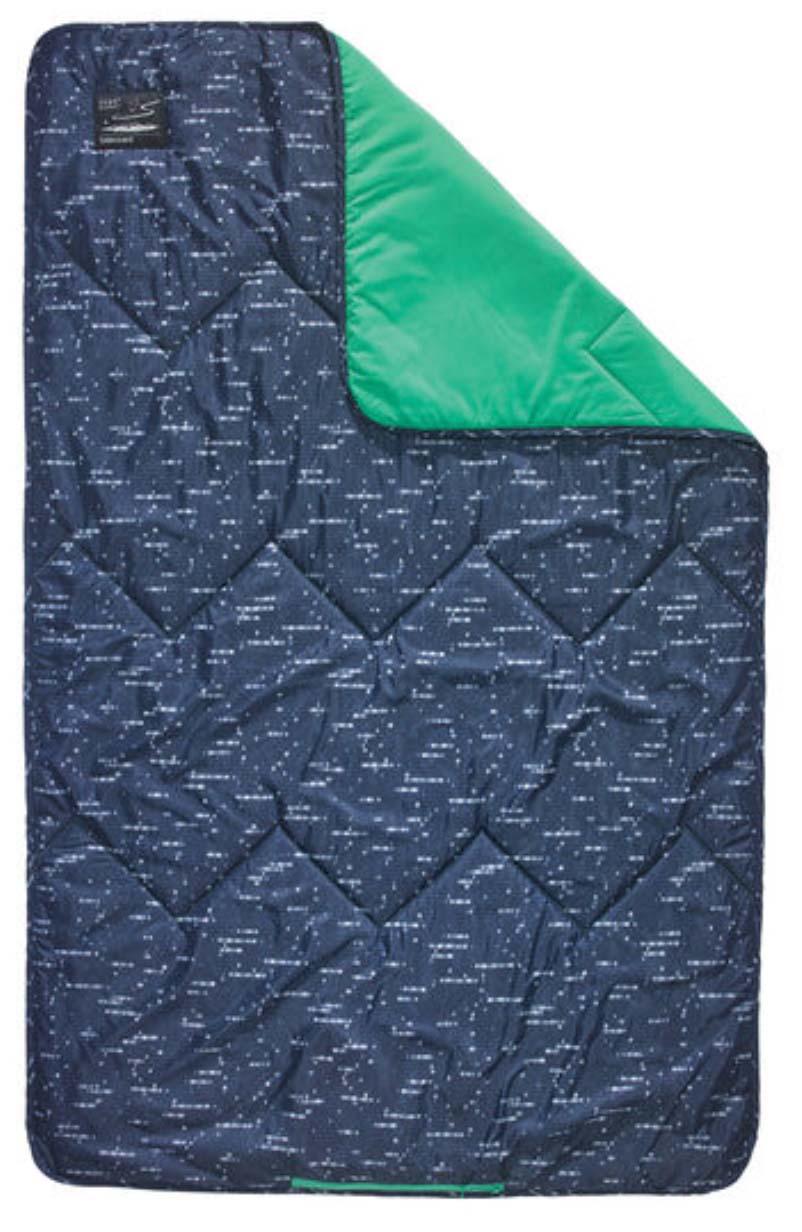 Insulation: Synthetic
Insulation: Synthetic
Weight: 13.5 oz.
Shell: 30D
What we like: The lightest blanket on our list.
What we don’t: Minimally insulated and less roomy than the competition.
Rumpl’s Down Puffy Blanket above is competitively light and packable thanks to its down fill, but $250 is a steep price to pay for a camping blanket. Enter Therm-a-Rest’s Juno Blanket, which checks in at a scant 13.5 ounces (5.7 oz. less than the Rumpl) and swaps the premium down fill for a cheaper synthetic variety to keep costs low. In testing the Juno, we found the polyester lining to be very soft and cozy against the skin, and snaps along the edge make it easy to fasten around your shoulders to go hands-free. It’s not quite as packable as the Down Puffy at 9.5 x 11 inches when stuffed down (the Rumpl is 5 x 10 in.), but it squeezes into its own pocket and takes up very little space in a car or duffel bag.
What’s not to like about the Therm-a-Rest Juno? For starters, it’s not very roomy at 72 inches long and 45 inches wide. For reference, both the Rumpl Down Puffy and top-rated Original Puffy (both 75 x 52 in.) provide noticeably better coverage around the upper body and legs when sitting down. Additionally, the Juno prioritizes weight over all-out warmth, meaning it’s not the best option for cooler temperatures (although it’s great on mild summer and shoulder-season nights). But at just $85, the Juno is another excellent value from Therm-a-Rest and feels a lot like their $15-pricier Stellar Blanket, which is roomier (75 x 56 in.) but heavier (1 lb. 6 oz.).
See the Therm-a-Rest Juno Blanket
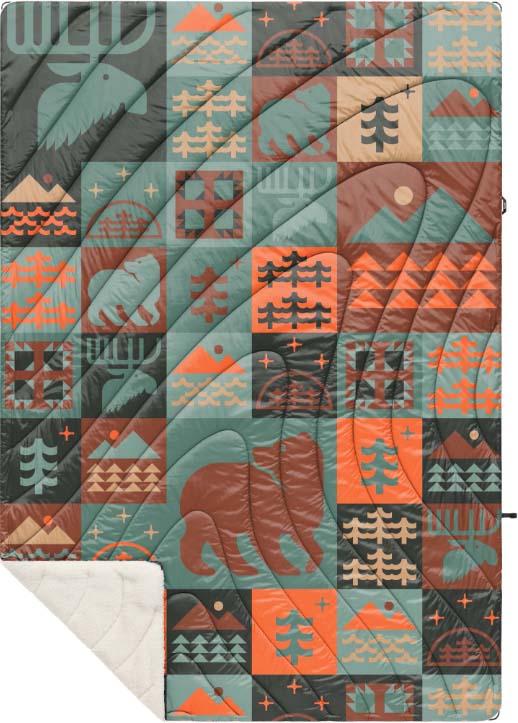 Insulation: Fleece
Insulation: Fleece
Weight: 2 lb. 14.4 oz.
Shell: 30D
What we like: Extremely cozy; hybrid design makes it easy to tailor warmth.
What we don’t: The white fleece will require added care outdoors.
The fourth and final Rumpl design to make our list this season is their Sherpa Puffy Blanket, which takes the top-rated Original Puffy and adds a fleece lining on one side for a sizable boost in comfort. The thick fleece is supremely soft and cozy against the skin, quieter than the Original Puffy’s all-polyester design, and helps keep the blanket in place throughout the night (smooth shells tend to slide around). On balmy nights, you can flip the blanket over and enjoy the cooler polyester side instead. Like all the Rumpl blankets here, the Sherpa Puffy also includes the brand’s useful Cape Clip and corner loops, as well as a handy carry strap. Finally, we love that the Sherpa Puffy looks the part both at camp and around the house, which isn’t the case with many other designs above.
All that said, fleece does come with some inherent downsides. First is weight: At nearly 3 pounds, the Rumpl Sherpa Puffy is almost a full pound heavier than the Original Puffy above while offering comparable warmth. As expected, packability is also less competitive at a fairly bulky 9 x 18 inches in its stuff sack, and fleece isn’t as protective in wind or wet weather as synthetics (although the Sherpa’s DWR coating will handle light moisture just fine). A final downside—and one that’s specific to the Sherpa—is the white fleece lining, which will require added care to avoid stains and wear from regular outdoor use. But for car camping, weekend cabin getaways, and throwing on your couch between trips, the Sherpa Puffy Blanket is easily one of the coziest options on the market.
See the Rumpl Sherpa Puffy Blanket
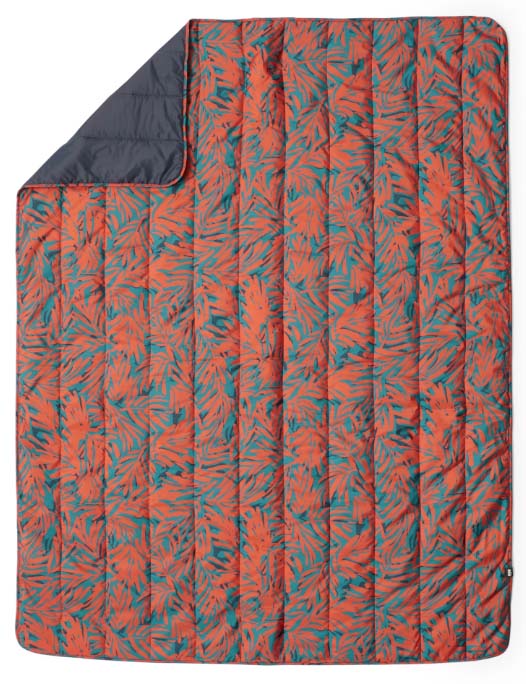 Insulation: Synthetic
Insulation: Synthetic
Weight: 1 lb. 6.9 oz.
What we like: Good comfort for the price and packs down small.
What we don’t: Barebones feature set and not a warmth leader.
REI Co-op consistently provides good bang for your buck, and their popular Camp Blanket is case in point. For $25 less than the Rumpl Original Puffy above, the Camp Blanket utilizes a similar synthetic build with a quilted construction to keep the insulation in place and minimize cold spots. Weight and packability are also pretty competitive, with the REI checking in at a reasonable 1 pound 6.9 ounces and measuring just 7 x 9 inches when stuffed down, which is noticeably smaller than the 7 x 16-inch Rumpl. It’s undeniably less lofty and warm, but we've found it nevertheless to be a great thin layer for around-the-campfire use or as a backup to keep young kids warm while sledding.
In addition to being on the thinner and less insulated end of the spectrum, the Co-op's Camp Blanket also falls noticeably short in another key area: features. It lacks everything from a hands-free cape clip to loops for securing it to the ground or another blanket. For around the same price, the Original Puffy is the better design: It's warmer, longer by 5 inches, and tacks on a variety of helpful features. But if you can use your member dividend or snag one during one of REI’s several sale periods throughout the year, the Camp is great to have as a supplemental or backup blanket.
See the REI Co-op Camp Blanket
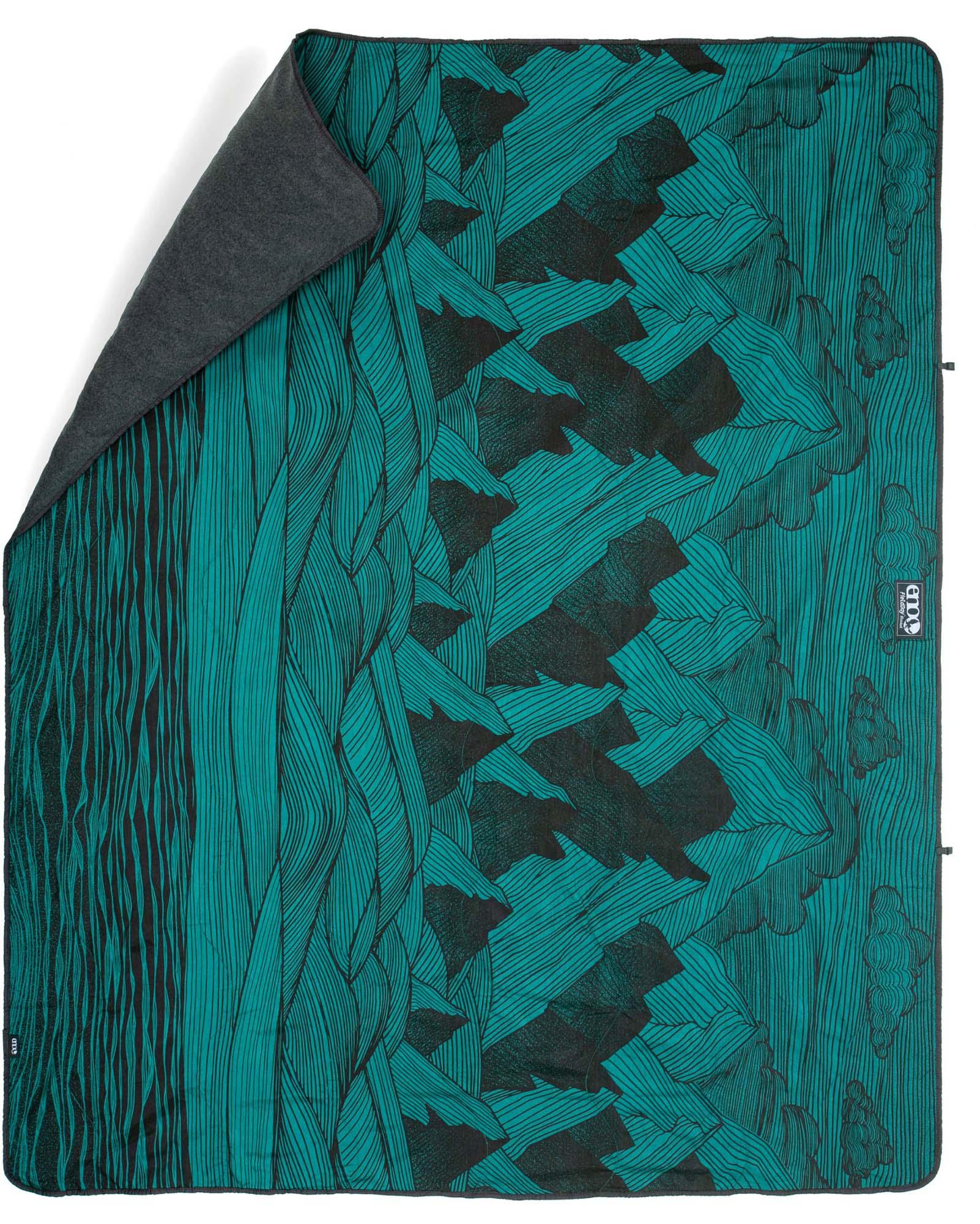 Insulation: Fleece
Insulation: Fleece
Weight: 2 lb. 8.0 oz.
Shell: 70D
What we like: Fleece lining is very soft and cozy.
What we don’t: Fleece doesn’t pack down as well as synthetic or down.
ENO (short for Eagles Nest Outfitters) is best known for their hammocks, but they've made a solid foray into the camping accessory market. Rather than synthetic or down insulation, their FieldDay here utilizes a fleece build that offers cozy warmth at an affordable price (fleece is well-loved as an insulator for its soft next-to-skin feel). From a durability standpoint, the quilted construction and thick nylon exterior are confidence-inspiring for use around camp (you don't have to worry about fill escaping through small holes) and boast a water-resistant finish for fending off light moisture and debris. And like the Rumpl blankets above, the ENO sports functional buckles that allow you to go hands-free with the blanket wrapped around you.
All that said, there’s a reason that most of the competition utilizes synthetic or down fill for warmth. Both are more expensive than fleece but offer improved warmth relative to their weight and packed size—the Eno is on the heavy end at 2 pounds 8 ounces and isn't very compressible (we have similar complaints about the fleece-insulated Rumpl Sherpa Puffy above). Synthetic also gets the slight edge in water resistance, although fleece will still keep you warm when damp. Whether or not the advantages are worth the trade-offs will come down to your priorities and preferences, but there’s no denying the ENO’s comfort and durability, which make it a great choice for camping with small children or dogs.
See the ENO FieldDay Blanket
| Blanket | Price | Insulation | Weight | Shell | Dimensions (LxW) | Packed Size |
|---|---|---|---|---|---|---|
| Rumpl Original Puffy Blanket | $125 | Synthetic | 2 lb. 1.6 oz. | 30D | 75 x 52 in. | 7 x 16 in. |
| Kelty Bestie Blanket | $25 | Synthetic | 1 lb. 8.6 oz. | 75D | 76 x 42 in. | 6.8 x 11.5 in. |
| Therm-a-Rest Argo | $125 | Synthetic | 1 lb. 10.0 oz. | 30D | 78 x 72 in. | 14 x 17 in. |
| Rumpl Down Puffy Blanket | $275 | 600-fill down | 1 lb. 3.2 oz. | 30D | 75 x 52 in. | 5 x 10 in. |
| Therm-a-Rest Honcho Poncho | $135 | Synthetic | 1 lb. 8.0 oz. | 20D | 79 x 56 in. | 11 x 17 in. |
| Pendleton Yakima Camp Blanket | $199 | Wool | 5 lb. 4.3 oz. | N/A | 84 x 66 in. | Unavail. |
| Yeti Lowlands Blanket | $200 | Synthetic | 5 lb. 12.8 oz. | Unavail. | 78 x 55 in. | Unavail. |
| Nomadix Festival Blanket | $70 | None | 2 lb. 0 oz. | Unavail. | 72 x 60 in. | Unavail. |
| Kelty Galactic Down | $125 | 550-fill down | 1 lb. 12.6 oz. | 50D | 72 x 55 in. | 7 x 12 in. |
| Rumpl NanoLoft Puffy Blanket | $180 | Synthetic | 1 lb. 12.8 oz. | 30D | 75 x 52 in. | 6 x 14 in. |
| Kammok Firebelly 30 | $300 | 750-fill down | 1 lb. 12.2 oz. | 20D | 88 x 55 in. | 14.2 x 7.1 in. |
| Therm-a-Rest Juno Blanket | $85 | Synthetic | 13.5 oz. | 30D | 72 x 45 in. | 9.5 x 11 in. |
| Rumpl Sherpa Puffy Blanket | $175 | Fleece | 2 lb. 14.4 oz. | 30D | 75 x 52 in. | 9 x 18 in. |
| REI Co-op Camp Blanket | $100 | Synthetic | 1 lb. 6.9 oz. | Unavail. | 70 x 54 in. | 7 x 9 in. |
| ENO FieldDay Blanket | $90 | Fleece | 2 lb. 8.0 oz. | 70D | 72 x 58 in. | 7 x 13 in. |
Camping blankets are a fun and versatile bunch—we use them for everything from cozying up around the campfire to lying on the beach or adding an extra layer of insulation on car camping adventures. Managing editor Sarah Nelson compiled our initial list of 15 blankets in early 2022, following an early-fall camping trip along the shores of Lake Wenatchee in Washington state that also involved testing camping lanterns and pillows. There, Sarah and two of her coworkers cozied up in about a dozen blankets throughout the week, carefully evaluating each design for warmth, comfort, water resistance, and overall performance. Currently based in Lake Tahoe but often on the road throughout the Mountain West, Sarah continues to test new and noteworthy blankets on trips all over the country.
In narrowing down our list to the 15 blankets you see above, we took several factors into account. Synthetic designs often hit the best middle ground between price and performance, which is why half of the picks above use synthetic fill. Premium down blankets offer more warmth for the weight but come with a cost penalty, while wool and fleece options are comfortable but not as light or packable as the competition. Other key considerations included dimensions, weather resistance, and shell thickness. Finally, the smaller details can make or break a design, so we make sure to use each feature (e.g., clips, buttons, and pockets) to ensure it works properly and holds up over time. Since the market is constantly changing, we’ve slotted this guide into an iterative update schedule to stay on top of the latest and greatest options.
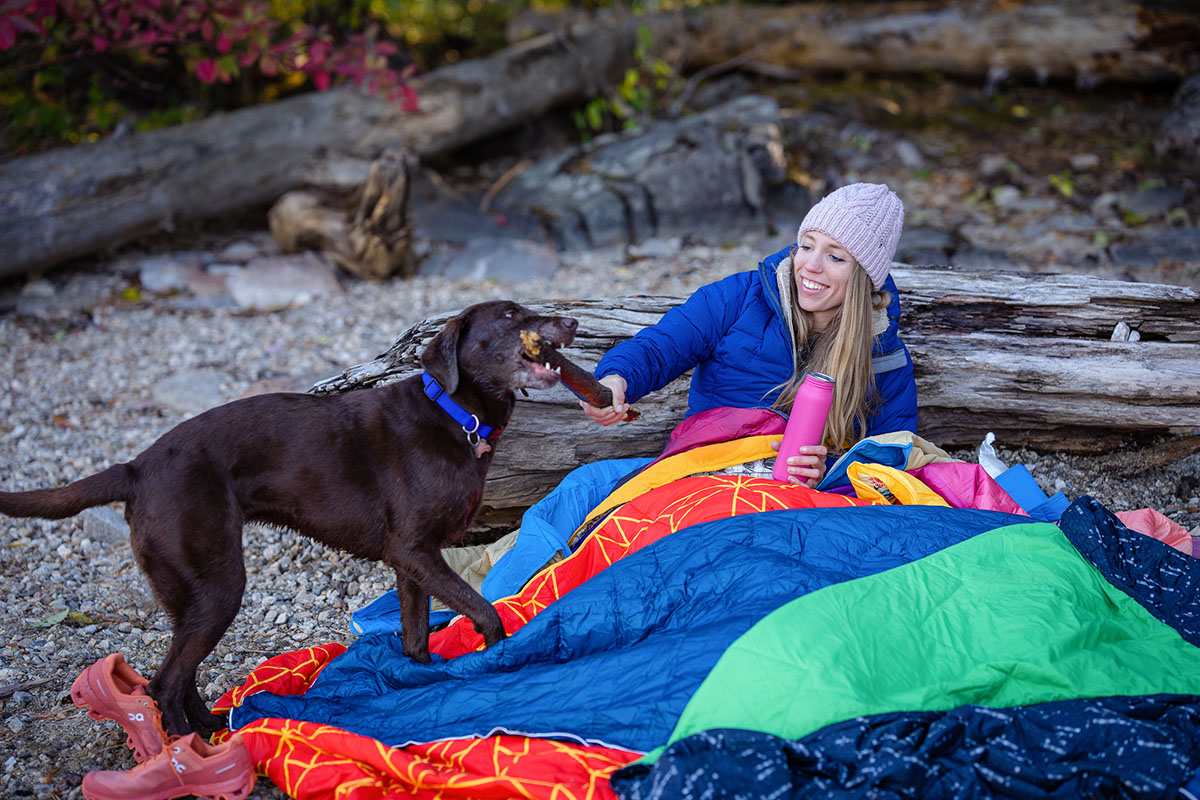
Synthetic
We see more camping blankets use synthetic fill than any other form of insulation, and the benefits are clear: Compared to down plumage that tends to clump up and stop insulating when wet, synthetic retains its loft and will continue to keep you warm. This gives it the clear edge for year-round use when your blanket might be exposed to moisture or dew from the ground. Synthetic fill is also more affordable (in most cases) and a bit better in terms of durability: If your blanket springs a leak, it won't scatter as easily as down feathers. It's true they're not weight leaders and don't pack down as small as down-filled blankets, but for car camping and other frontcountry uses, we think the benefits far outweigh the trade-offs. Some of our favorite synthetic-insulated models include Rumpl’s Original Puffy and NanoLoft Puffy and REI Co-op’s Camp Blanket.
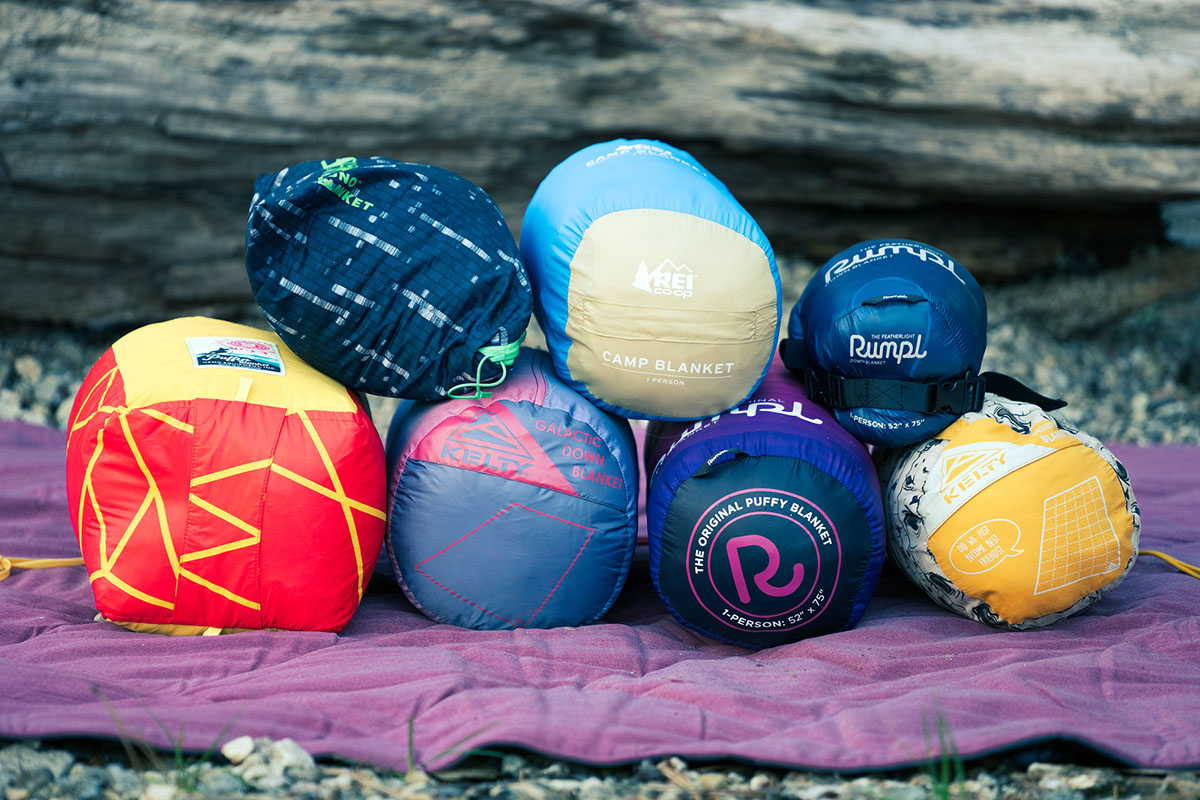
We’d be remiss not to mention down-mimicking synthetics here, which have seen notable advancements in recent years and come closer and closer to matching the packability and warmth-to-weight ratio of down. One standout is Rumpl’s NanoLoft, which does an excellent impression of down: It’s lofty, offers great warmth for minimal weight, and compresses down reasonably well. These insulations still can’t match down’s naturally light and compressible properties and generally cost more than cheaper synthetic varieties, but they’re a nice man-made alternative and often save you a good chunk of change compared to premium down models.
Down
As we mentioned above, down holds the warmth-to-weight crown, packs down very well, and is typically very cozy and soft. Down quality is measured in terms of fill power, with higher-fill-power varieties offering excellent warmth at a very low weight and packed size. For example, Rumpl’s top-end Featherlite Blanket (not included here) boasts lofty 800-fill-power down, checks in at a scant 1 pound, and compresses down to just 5 x 8 inches when packed (ideal for stuffing into a pack and heading into the backcountry). Blankets with lower-fill-power down—like the 600-fill in Rumpl’s Down Puffy, 750-fill in Kammok’s Firebelly 30, and 550-fill in Kelty’s Galactic—require more insulation (i.e., more weight) to achieve similar levels of warmth, are less lofty, and don’t stuff down as small, but they still get the edge over most synthetics.
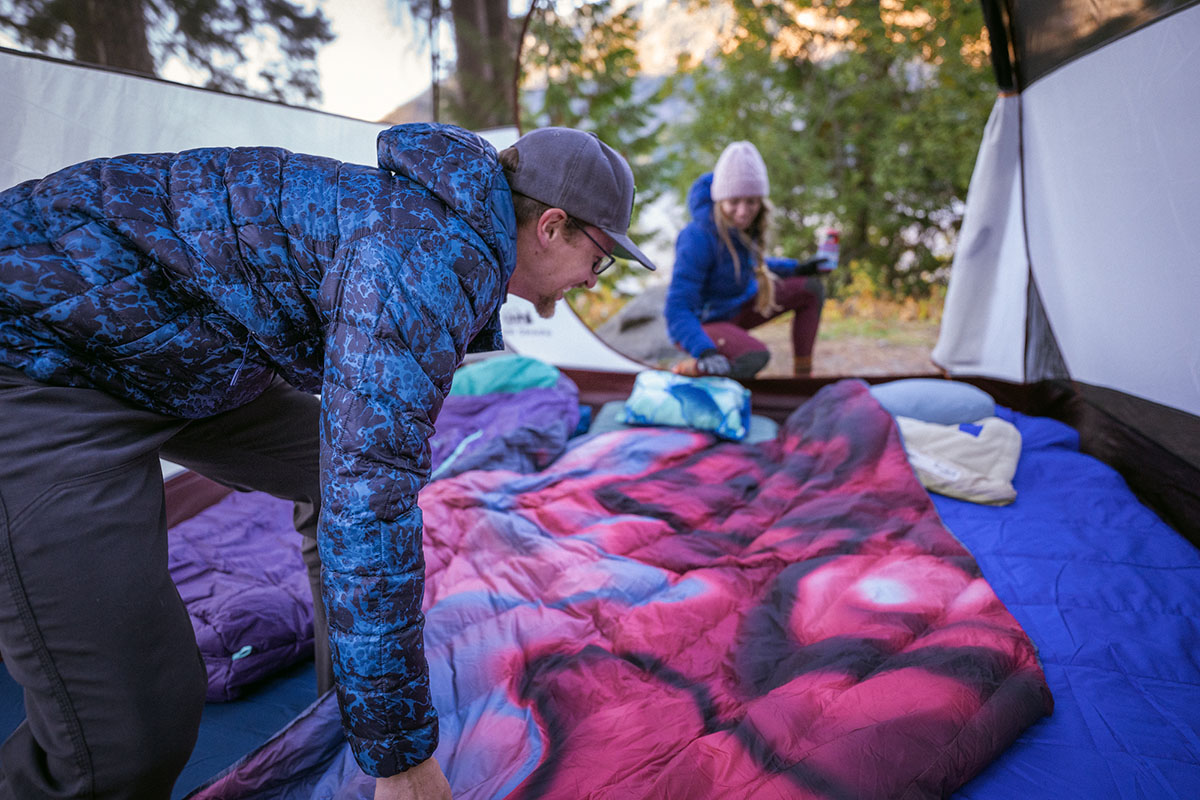
The biggest sacrifice in opting for a down-insulated blanket is the lack of wet-weather assurance. Down tends to clump up and stop insulating when wet, which is a notable drawback for those who camp in damp climates. That said, some higher-end designs—like Rumpl’s Featherlite and Down Puffy Blanket—add a hydrophobic treatment to the insulation, which allows it to resist moisture better than untreated down and maintain much of their loft and insulating properties when wet. A final drawback is that down blankets have more of a tendency to leak over time and slowly lose their warmth. If you go the down route, it’s important to exercise caution to avoid snagging or tearing the shell and massage any protruding feathers back into place rather than pull them out. In the end, unless weight and packability are top considerations, we'd recommend against down fill—the pros simply don't outweigh the cons.
Wool
In addition to synthetic and down, wool is another—albeit far less popular—insulation type for camping blankets. We included just one wool-insulated design on our list (the Pendleton Yakima Camp Blanket), but there are some clear benefits to consider. Namely, wool is naturally resistant to odors, wicks moisture well, and is very soft and comfortable next-to-skin. Most importantly, it's really warm. But unlike synthetic or down fill, wool isn't lightweight or lofty, doesn't stuff away into a small packed size, and can be a pain to clean (the aforementioned Pendelton is dry clean only). We keep a Pendleton blanket in our van at all times, but its bulky build means it wouldn't be our first choice when packing for a camping trip or weekend at the cabin.
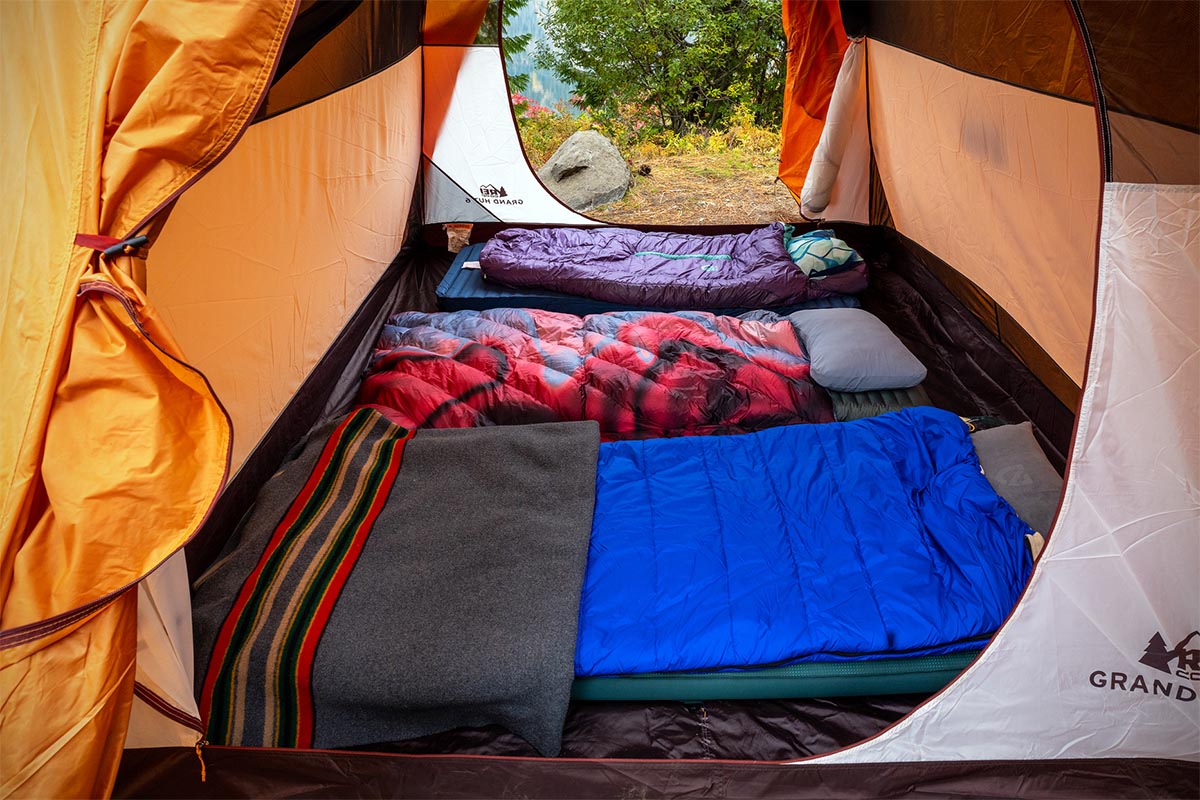
Fleece
A final insulation type to consider is fleece, which is used in designs like the Rumpl Sherpa Puffy and ENO FieldDay blankets above. The biggest draws here are comfort and affordability: Fleece has an inherently soft and supple feel and typically costs considerably less than most synthetic and down insulations (the Sherpa Puffy is one exception at $175 compared to the $125 Original Puffy). In terms of downsides, fleece isn’t as light or packable as the competition and falls well short of synthetics in wind and wet-weather protection. Most fleece blankets–including the ENO mentioned above–are also on the thinner end of the spectrum and offer minimal warmth (they’re suitable for summertime use or as a supplement to a quality sleeping bag). But for fair-weather and budget-oriented campers who don’t want to sacrifice comfort, fleece blankets have their place.
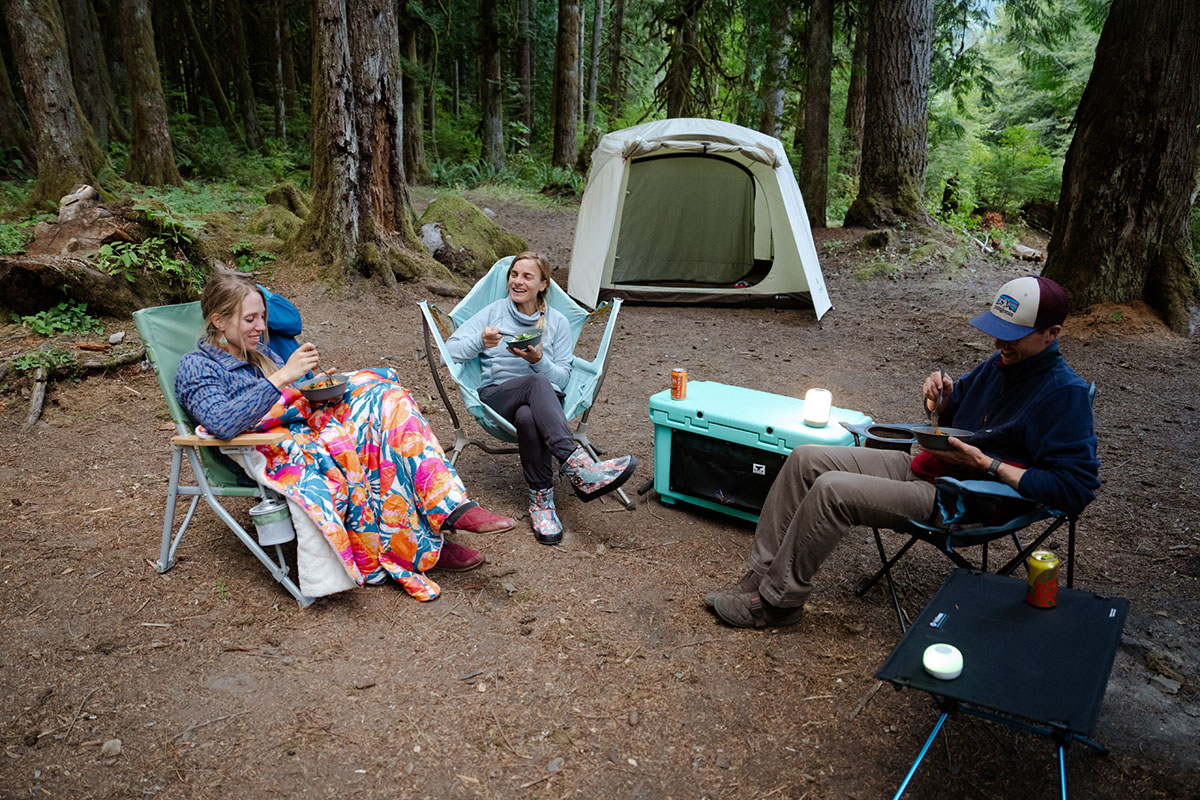
All of the camping blankets above offer enough coverage for most average-sized adults, but some are more generously sized than others. Kammok's Firebelly is one standout at 88 inches long by 55 inches wide, which makes it easy to wrap fully around your shoulders and body. By comparison, all of the Rumpl models that made our list are notably shorter at 75 inches long but 2 inches wider, which is still plenty big for most campers (and importantly, we’ve had no issues with coverage).On the other hand, Kelty’s Bestie is one of the narrowest options on our list with just 42 inches at the shoulders (it’s around 75.6 in. long) and is noticeably harder to wrap around your upper body to trap warmth. If you’re on the taller end or have a broader build, these could be important specs to consider. We call out any major deviations in the write-ups above, and we’ve also listed the dimensions in our comparison table to make it easy to compare between models.
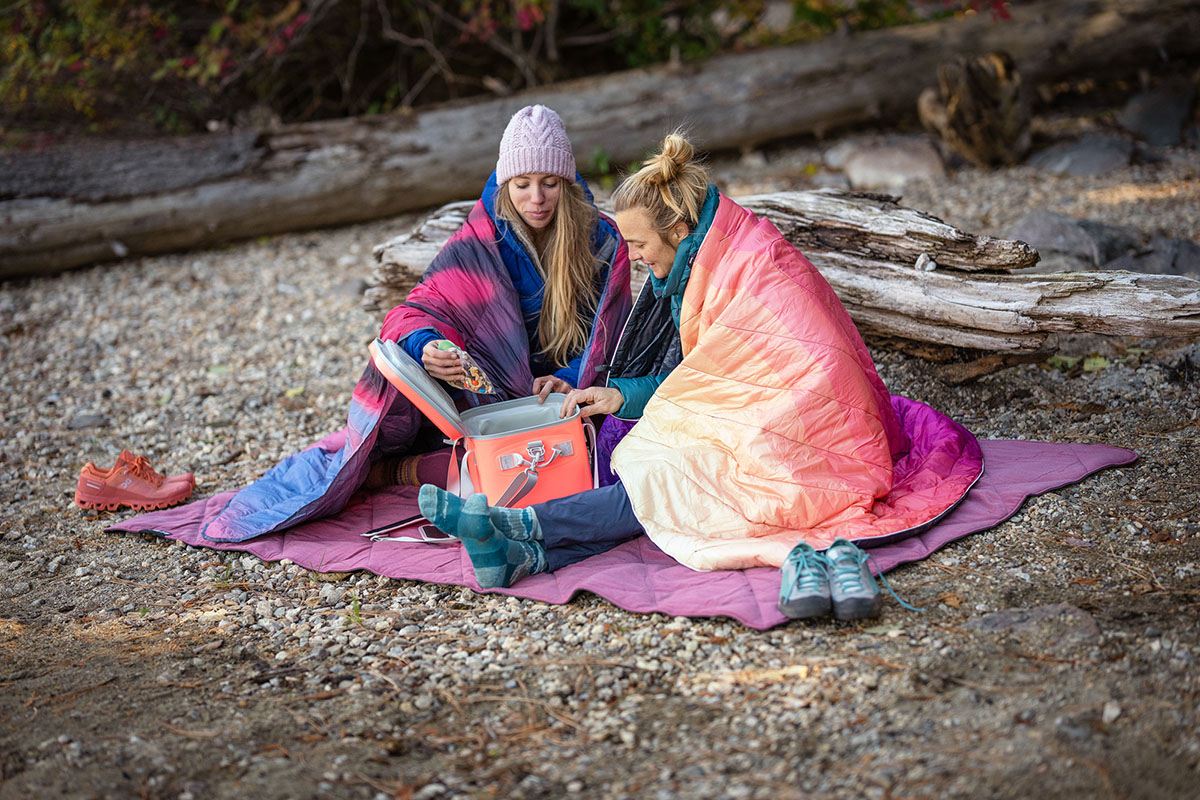
Double (Two-Person) Blankets
For those who regularly camp with a partner or significant other, it may be worth considering a roomier double camping blanket like Therm-a-Rest’s Argo, which measures 78 inches long by 72 inches wide and offers excellent coverage for two. Rumpl also makes two-person variations of all four of their offerings above: the Original Puffy, NanoLoft Puffy, Down Puffy, and Sherpa Puffy. In the end, double blankets have their appeal for those who frequently get out with a partner and/or appreciate the extra coverage when sleeping, but they’re generally heavier, less packable, and cost more than one-person models. In most cases—whether you're lounging by the fire, sitting on a tailgate, or wrapped up on the porch—a camping blanket is a personal item and a single-sized version is all you need.
Camping blankets vary considerably in terms of warmth, ranging from thin and lightweight fleece designs to lofty down-insulated models. That said, it can be tough to get an accurate idea of warmth from the specs alone. Given their more casual slant, most blanket manufacturers don't provide fill weight (which indicates how much down is in a given blanket), and even the synthetic options lack a g/m2 spec. This can make it hard to get a realistic comparison between models, but we use overall weight and personal experience to call out any obvious warmth discrepancies in our write-ups above (when comparing blankets of similar fill types, more weight generally means more warmth). For example, the 2-pound-1.6-ounce Rumpl Original Puffy packs in significantly more insulation than the 1-pound-8.6-ounce Kelty Bestie (both blankets use synthetic fill).
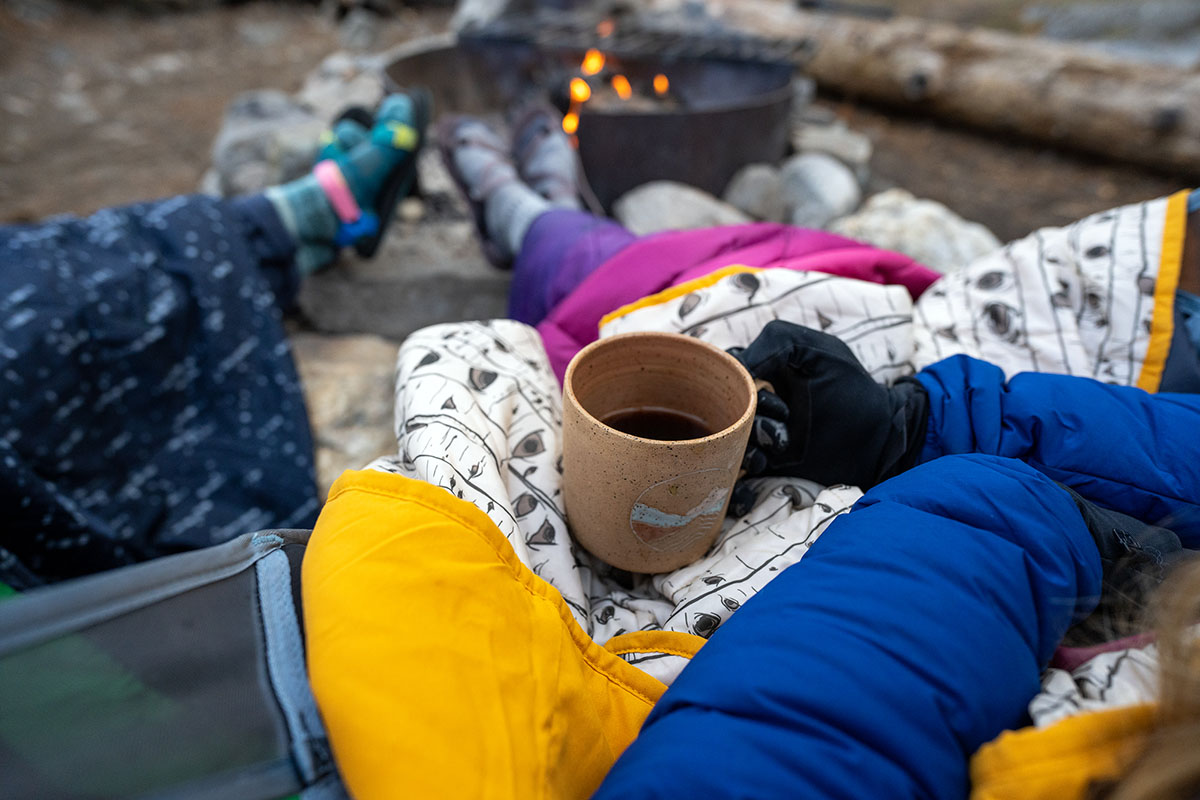
Comfort is largely subjective, but there are undeniable differences in hand feel between budget and premium designs. For instance, Kelty’s Bestie costs just $25 but uses decidedly cheaper-feeling materials that lack the soft, supple coziness of pricier picks like Rumpl’s Original Puffy and NanoLoft Puffy (we have all three, and it’s telling that we reach for the Rumpls most frequently). As we touched on above, down tends to be cozier and loftier in general, with higher-fill-power varieties boasting impressive loftiness and a pillowy-soft feel. Fleece is also naturally soft and supple, but blankets like the ENO FieldDay are thin and provide minimal warmth. And wool designs like the Pendleton Yakima are also highly comfortable but lack the cozy warmth and sleeping bag-like feel of synthetics or down. The lesson here: Spending up will almost always translate to better comfort, but where you draw the line is entirely a matter of personal preference.
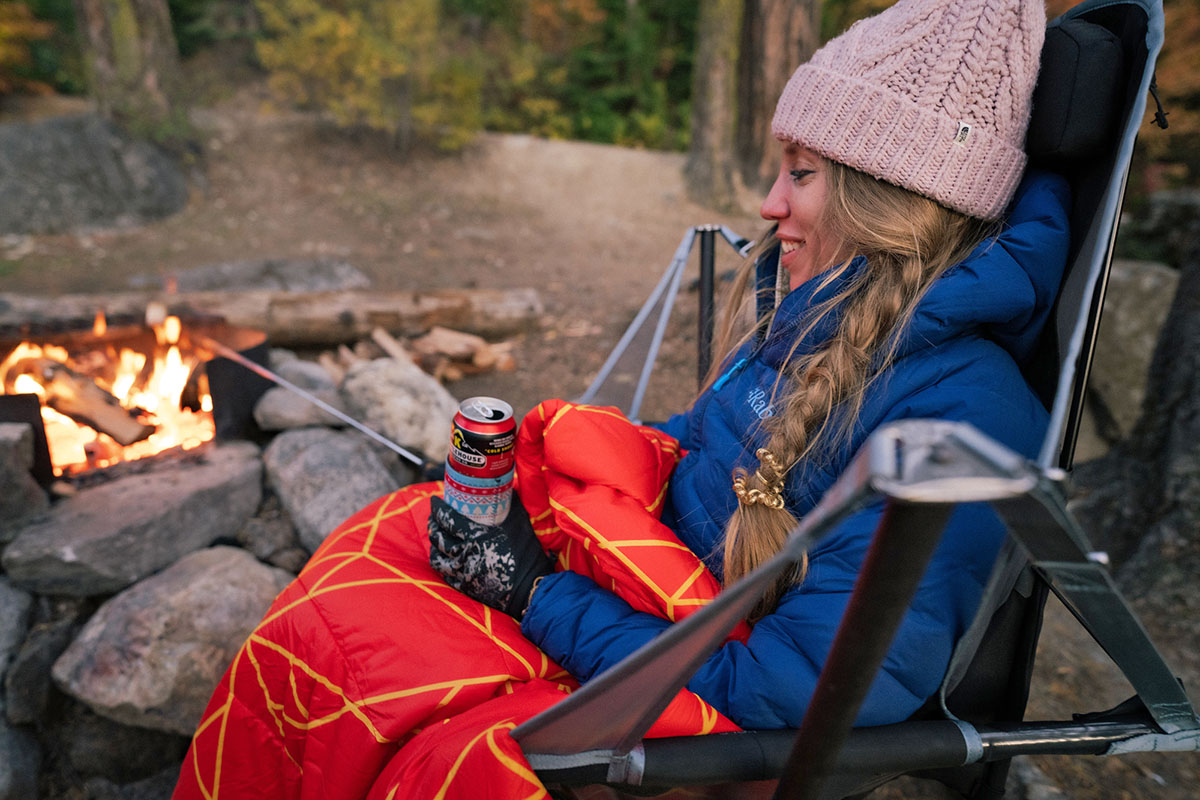
Unless you’re bringing your camping blanket along on your next backpacking or bikepacking adventure, weight and packability are of little concern. That said, there’s still a fairly wide spread between models, and some camping blankets are noticeably less bulky and cumbersome to haul around than others. For reference, the lightest blanket on our list is Therm-a-Rest’s Juno Blanket, which clocks in at a scant 13.5 ounces and measures a respectable 9.5 x 11 inches when packed down. On the flip side, burly wool and waterproof builds like the Pendleton Yakima and Yeti Lowlands easily exceed 5 pounds and will take up a considerable amount of space in your duffel bag, gear bin, or vehicle. Most options fall somewhere in the middle (1-2 lb. and roughly the size of a loaf of bread), which is entirely manageable for most uses.
The vast majority of camp blankets have a shell fabric protecting the insulation, and the thickness of this fabric is measured in denier (technically it's the thickness of the individual threads, but the two are directly correlated). We've included this spec in our table above, and the models on our list range from 20 to 75 denier ("D" for short). At the minimalist and fragile end of the spectrum are designs like the Rumpl Featherlite, which boasts a 10-denier shell that’s concerningly thin and susceptible to tears and snags from branches, rocks, and pets (hence our decision to leave it off the list above). These blankets are exceptionally light and packable, but the sacrifice in durability is a noteworthy concession and limits their overall appeal and versatility.
On the flip side, budget models like the Kelty Bestie Blanket (75D) and ENO FieldDay Blanket (70D) are far more hardwearing and confidence-inspiring for rough use, and we feel much more comfortable throwing them haphazardly in our tent or the back of our vehicle. Yeti's premium Lowlands is another standout here, with a decidedly robust and waterproof build that works well for use as a ground tarp. Again, the trade-off is added weight and bulk, but those penalties may be worth it for campers that tend to be rough on their gear. In the end, the weight-versus-durability equation isn’t entirely clear-cut and comes down to a matter of personal preference, but we’ve found the sweet spot of toughness and packability to be around 20 to 50 denier. And regardless of thickness, you’ll want to be especially careful when using your blanket around the campfire, as flying embers and sparks can quickly burn through even the thickest of shells (more on this below).
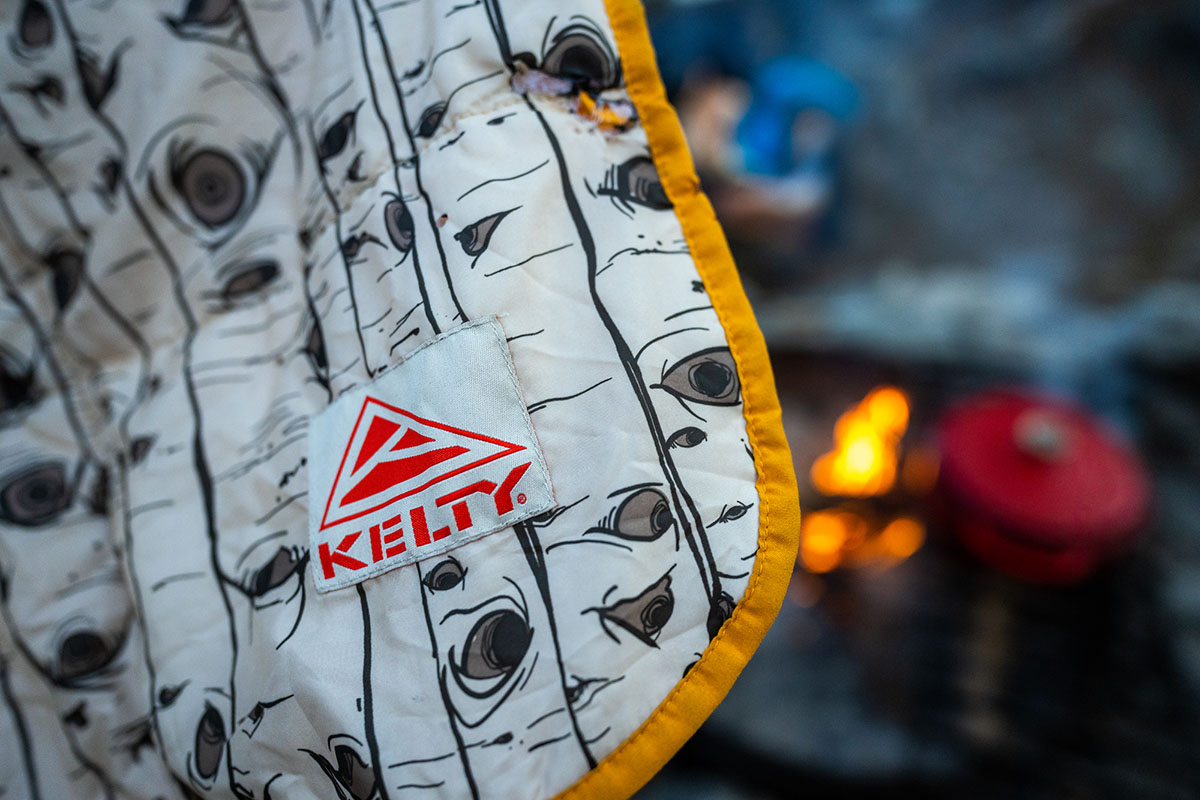
Fire Resistance
As we touched on above, most camping blankets are susceptible to holes from flying embers, and it’s important to exercise caution when sitting by the campfire to avoid burning through the shell fabric. That said, certain models are better equipped to handle the abuse than others. Wool designs like the Pendleton Yakima, for example, fend off holes from embers much better than synthetic alternatives. Rumpl takes it a step further with their NanoLoft Flame Blanket (mentioned in the NanoLoft Puffy write-up above) with a proprietary fire-resistant exterior, although it’s noticeably less soft and comfortable than the standard version. Whether or not that trade-off is worth it is up to you, but we’ve managed to keep most of our blankets—even the thinner and more delicate ones—in good shape with a little extra vigilance and attention when sitting around the campfire.
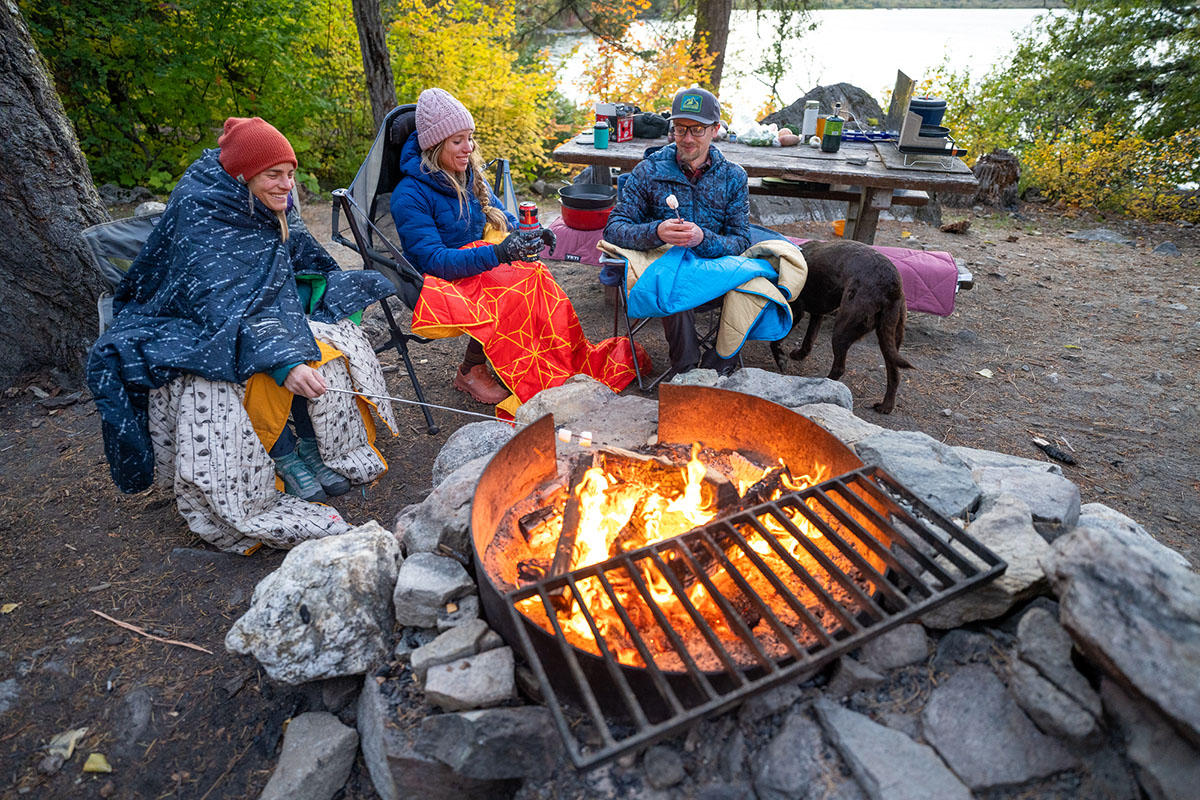
As we covered in the insulation section above, synthetic is the clear leader in weather protection and will keep you warm even if it gets wet. Wool and fleece also insulate when wet, but if they lack a shell fabric for protection (like the Pendleton), they'll soak up moisture pretty rapidly. Down, on the other hand, clumps up when exposed to moisture and can quickly lose its insulating properties, which we experienced firsthand with Kelty’s Galactic Down Blanket after laying it on the ground in damp morning dew.
If you’ll be occasionally out in the wet—such as winter tailgating or some après ski activities—it’s a good idea to select a blanket that has a durable water repellent (DWR) coating on its shell, which helps keep light rain and snow from absorbing into the fabric. And this goes almost without saying, but no blanket will stand up to truly inclement conditions or deluges, so it’s best to minimize exposure to moisture regardless of which design you choose.
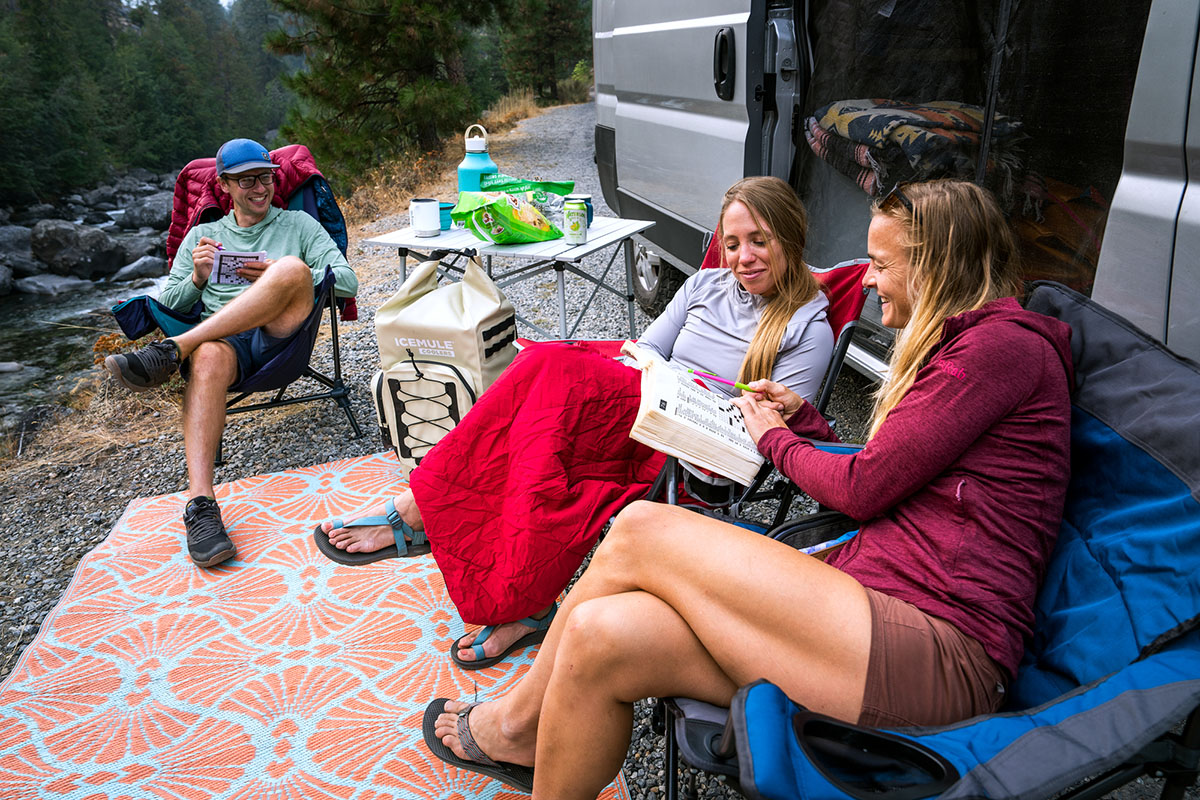
Waterproof Camping Blankets
Water-repellent treatments are relatively standard among mid-range and premium camping blankets, but some designs take it a step further with fully waterproof constructions. Yeti's Lowlands is one example, with a durable and waterproof base and highly water-resistant top that easily shrugs off moisture, pet hair, and other debris. This makes it an excellent option for use as a ground tarp or picnic blanket in damp weather, but its stiff build is less cozy to wrap around yourself. Nemo’s Victory Picnic Blanket (not included here) is another design that sports a waterproof bottom, although it’s uninsulated and lacks the two-in-one versatility of the Lowlands. In the end, our take is that full waterproofing has its place for protecting you from cold and wet ground, but most campers will be better off with a traditional and far suppler non-waterproof design.
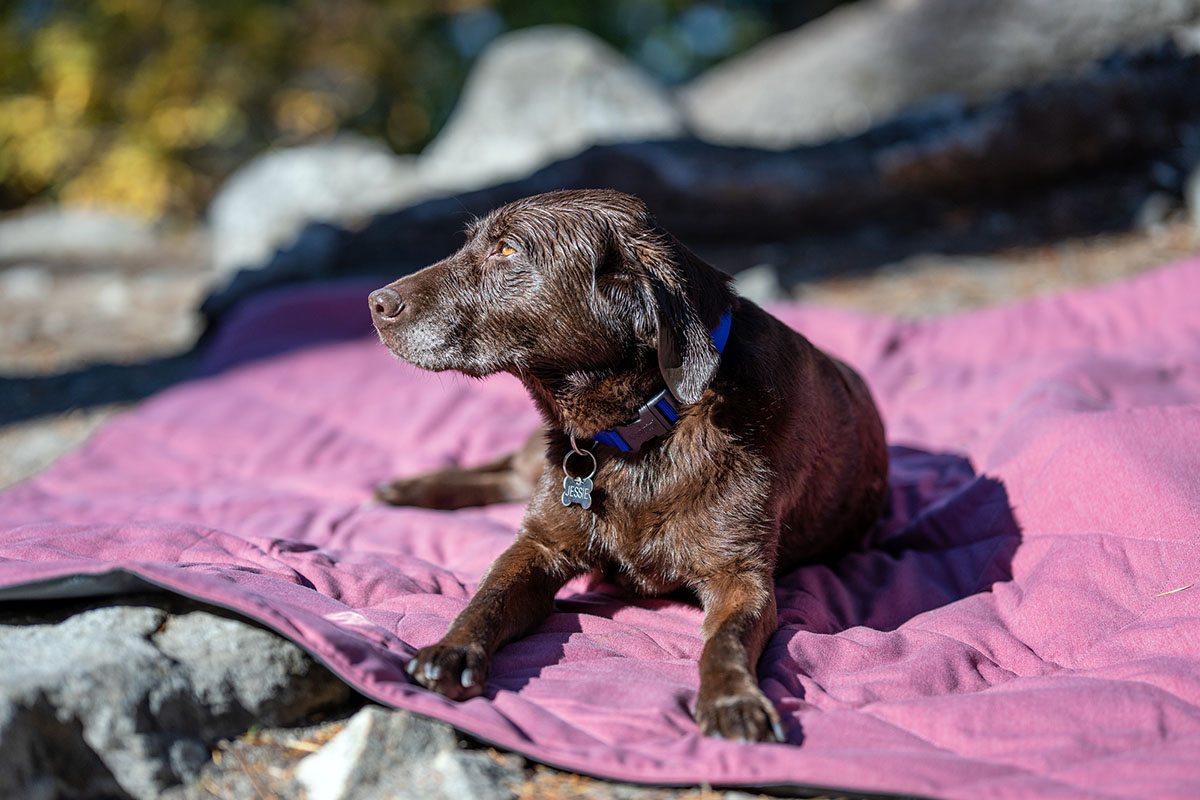
Modern camping blankets are a fun bunch, with many of our favorite picks boasting functional warmth-trapping features. We especially love buttons or snaps that allow you to go hands-free with the blanket wrapped around you, which Rumpl utilizes on all of their offerings above and make it easy to quickly secure the blankets around you while performing camp chores. Most also include loops at the corners to tether down inside a tent or on blustery days. A final feature worth calling out is Therm-a-Rest’s attachment system on their Argo and Stellar blankets (the latter is not included above), which consists of drawcords at the feet and perimeter snap loops to secure to another Therm-a-Rest blanket or quilt.
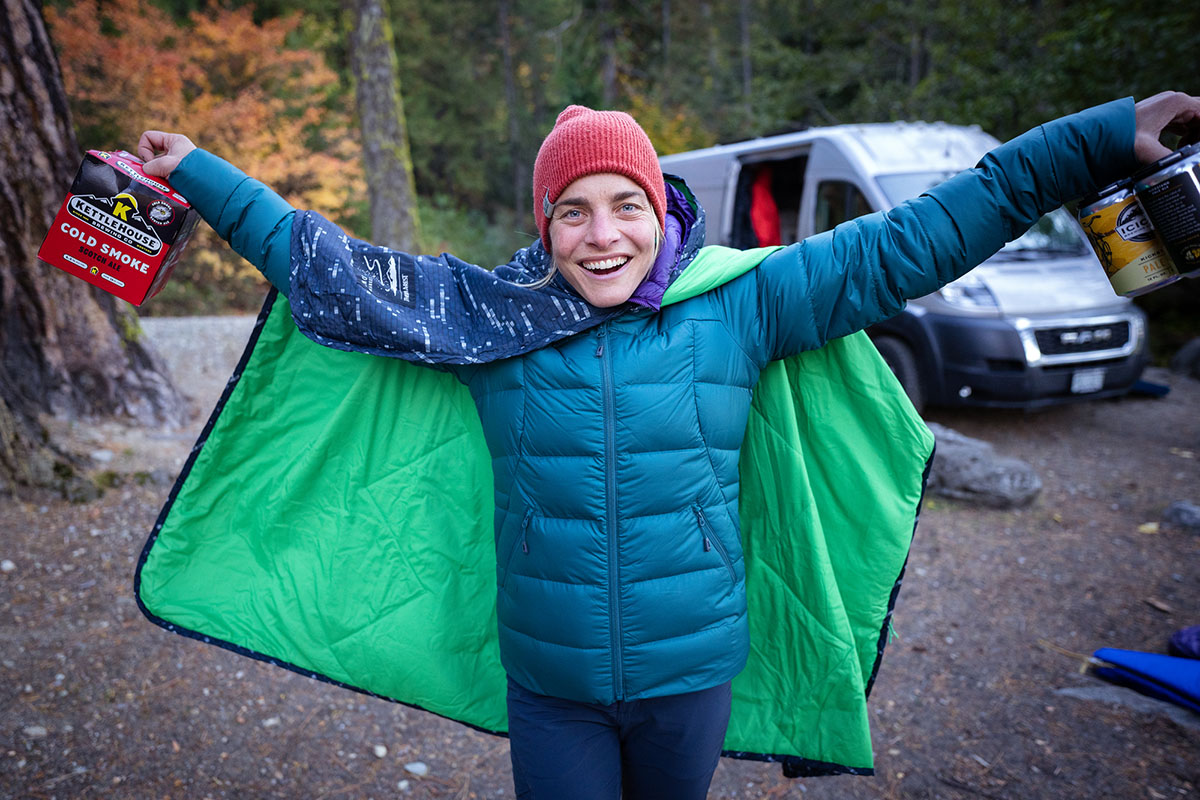
Poncho-Style Camping Blankets
While many camping blankets boast snaps or buttons to secure around your body, poncho-style designs like the Therm-a-Rest Honcho Poncho take it to the next level with added features like hoods and pockets. Not everyone will be a fan of the unique styling, but we consider poncho blankets a great option for those who run cold—simply slip your head through the opening, don the hood, and snap the sides together for maximum coverage around camp. Importantly, most poncho designs can also be used as standard blankets, which is a nice option on warm evenings or for throwing on top of your sleeping bag on cooler nights.
We’ve seen a sizable uptick in the use of sustainable practices among outdoor brands of late, and many modern camping blankets are made with the environment in mind. Rumpl is a clear leader in this realm: Their Original Puffy Blanket is made using recycled plastic bottles, and their Down Puffy uses sustainably sourced duck down that’s a byproduct of the food industry (read: no live plucking) and certified to the Fair Trade standard. REI is another brand that’s been at the forefront of the sustainability push, and their Camp Blanket utilizes bluesign-approved materials that have been deemed safe for workers, consumers, and the environment. It’s worth noting that many other outdoor products now use PFC-free DWR coatings that forgo the use of per- or polyfluorinated chemicals—"forever chemicals" known to be harmful to the environment—but we haven’t seen that shift in the camping blanket market yet.
Most of the camping blankets above are machine-washable (the dry clean-only wool Pendleton is one exception) and can be dried with your other laundry, which makes caring for them quick and easy. That said, we always recommend checking the manufacturer’s care instructions before throwing your blanket in the washer or dryer, and it’s best to use “delicate” settings whenever possible. For down blankets in particular, we’ve found that adding tennis balls into the dryer can help revive the thick, lofty feel. And if you see any feathers poking out, you'll want to massage them back in to minimize the risk of reducing warmth.
As far as storage goes, it’s best to remove your camping blanket from its stuff sack when you return and keep it unstuffed in your gear bin or garage. This is because compressing the insulation for long periods can considerably reduce its loftiness and insulating properties. This is more of a consideration for down, but high-loft synthetics like Rumpl’s NanoLoft can also pack out over time if left compressed for extended stretches.
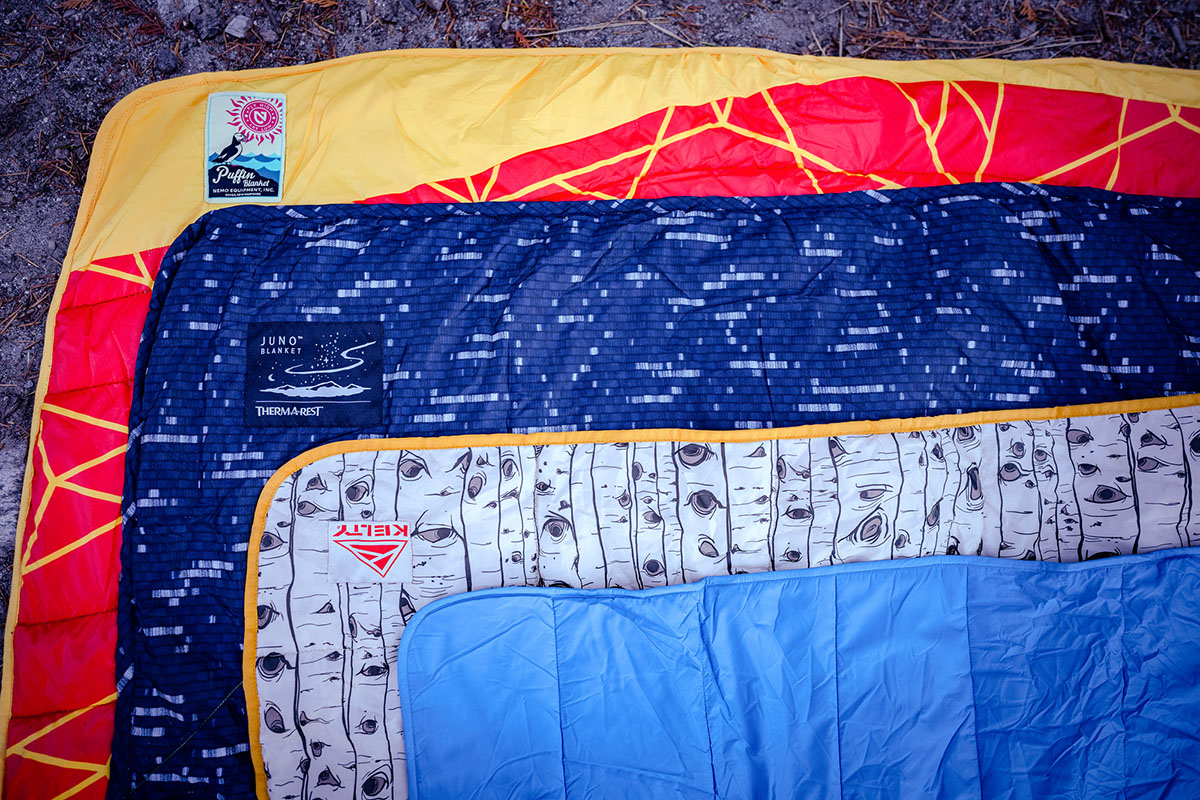
A blanket can be a fun and functional addition to your camping, vanlife/camper, or cabin kit, but most designs are too heavy and bulky and lacking in practical features to use in the backcountry. For those aiming to travel fast and light, an ultralight sleeping quilt is a better choice. These designs forego the hood and back of standard sleeping bags, but many sport critical warmth-trapping features like rear closures that allow you to secure them around you, footboxes that close shut with a zipper or snaps and bottom drawstring, and useful attachments to secure to your sleeping pad. Further, many top designs utilize high-fill-power down that’s lofty and warm at a minimal weight, highly packable, and will keep you comfortable in most three-season conditions (down to around 20 degrees Fahrenheit). High-end models are undeniably pricey with many easily exceeding $300, but for committed backpackers and thru-hikers, the investment may be worth it. For a full list of options, see our article on the best ultralight sleeping bags and quilts.
Back to Our Top Camping Blanket Picks Back to Our Blanket Comparison Table